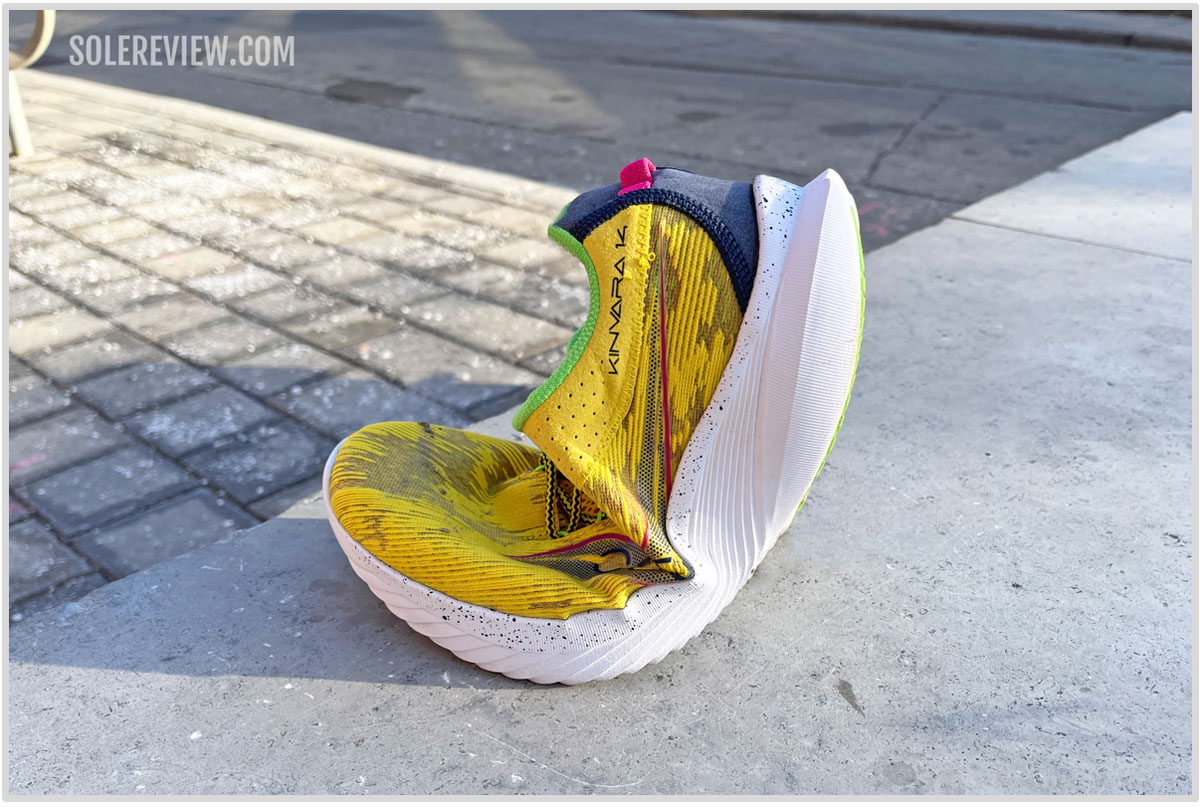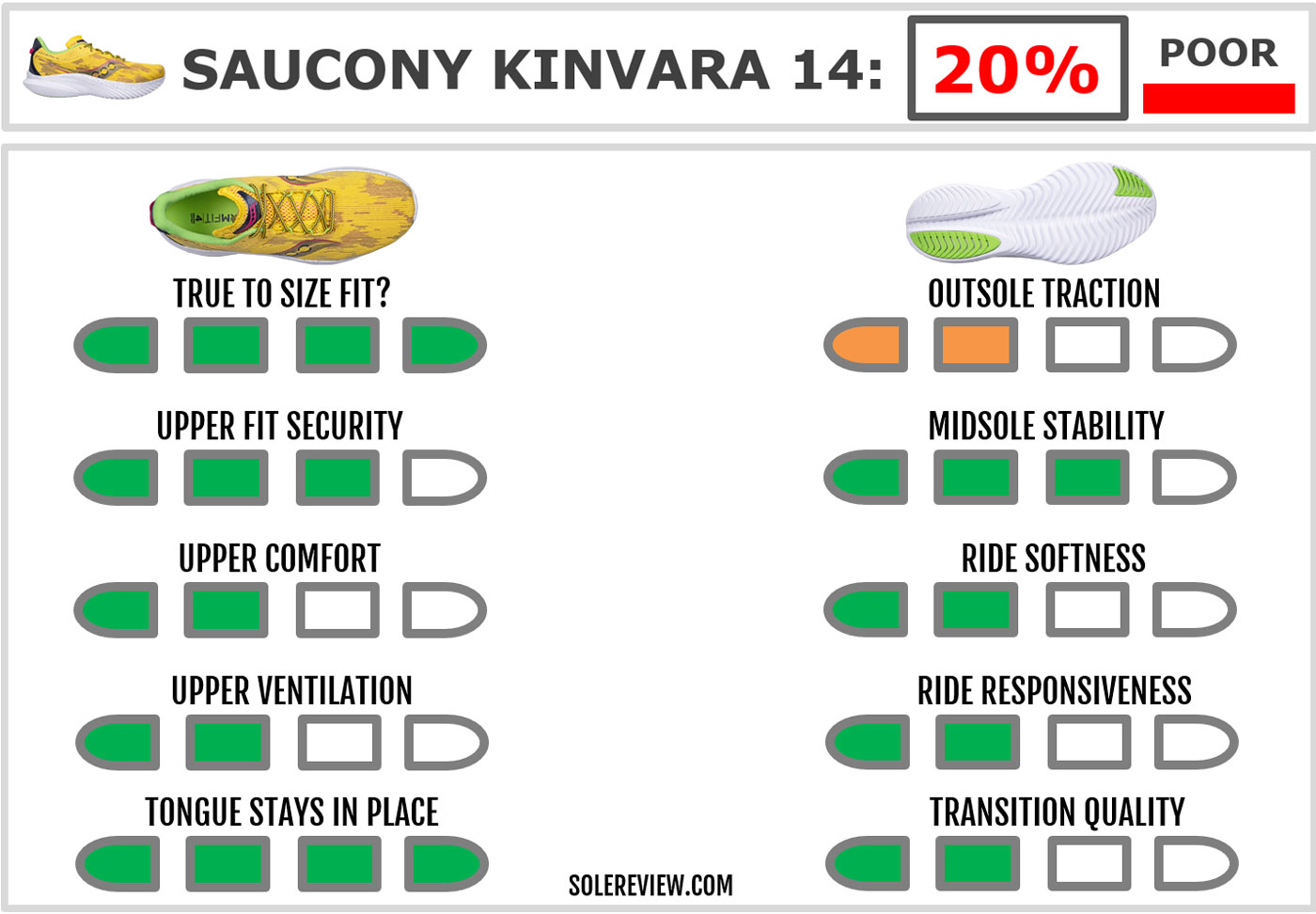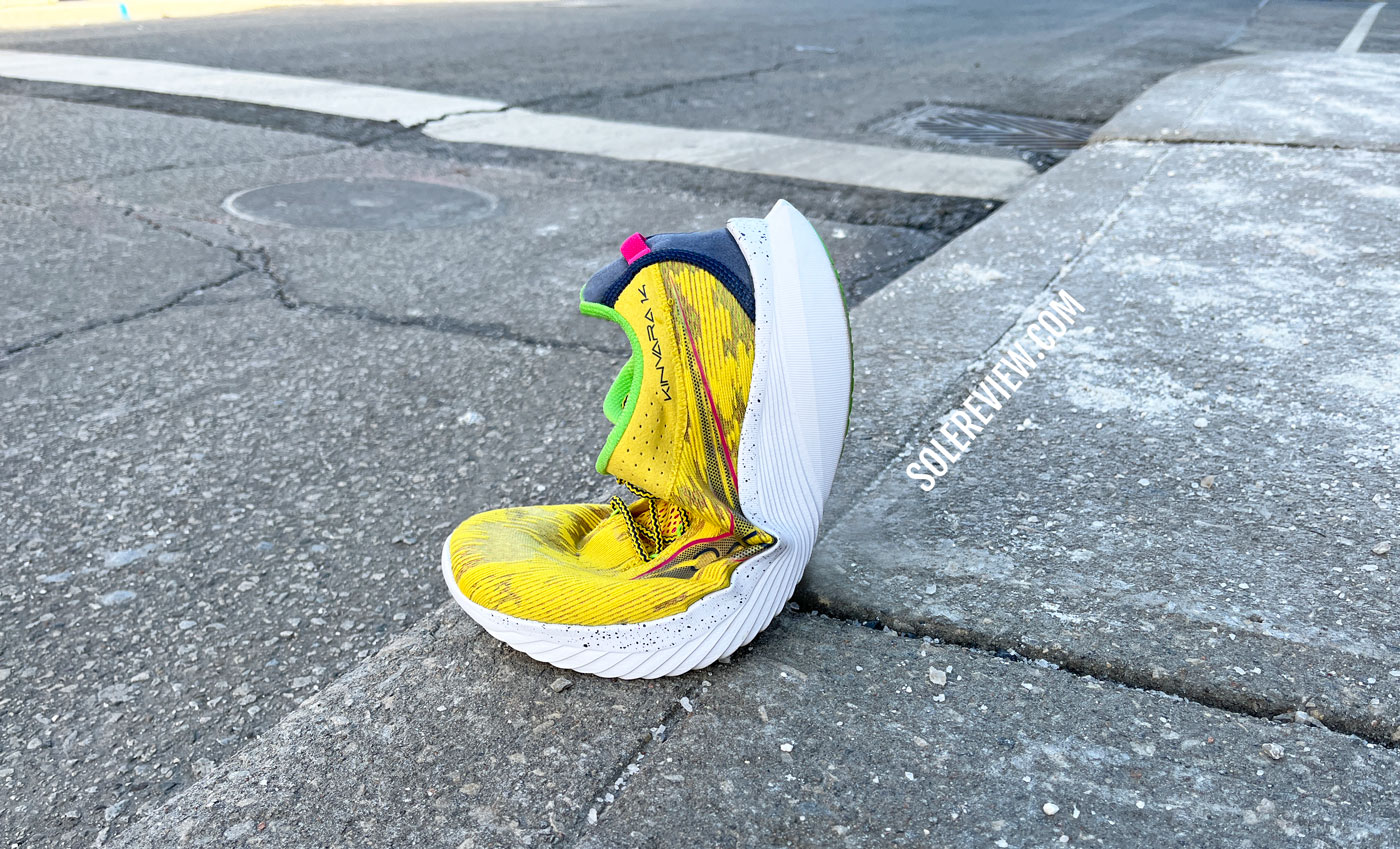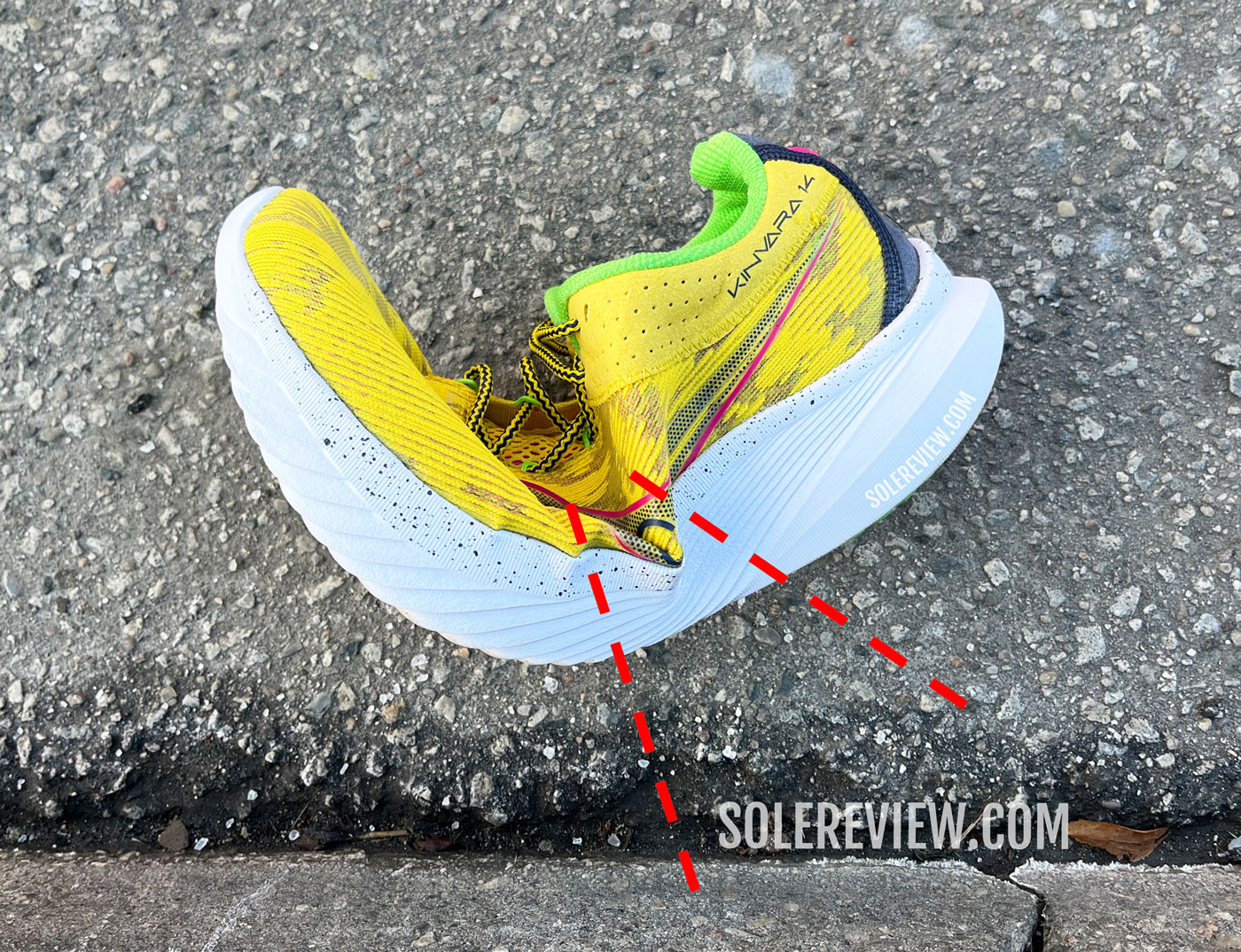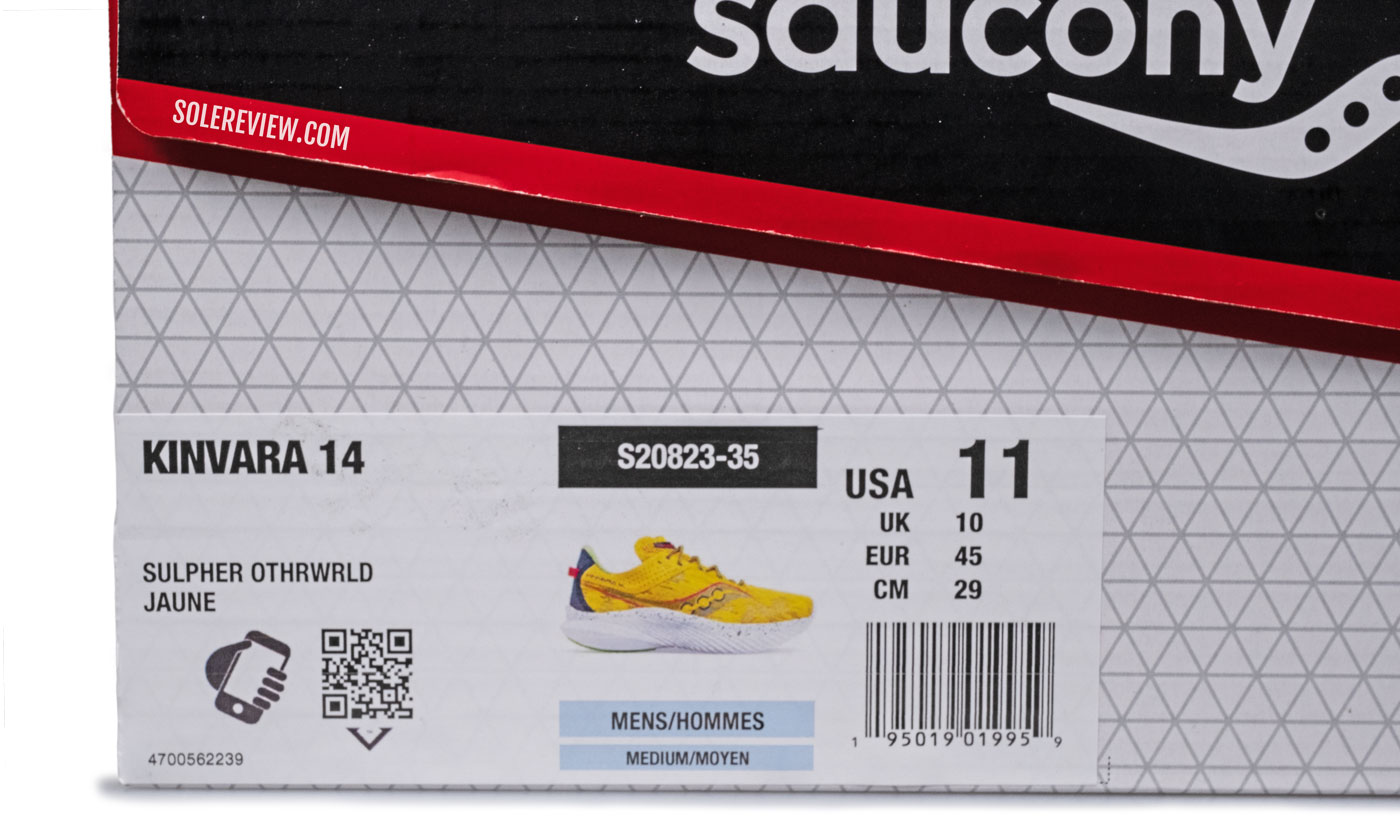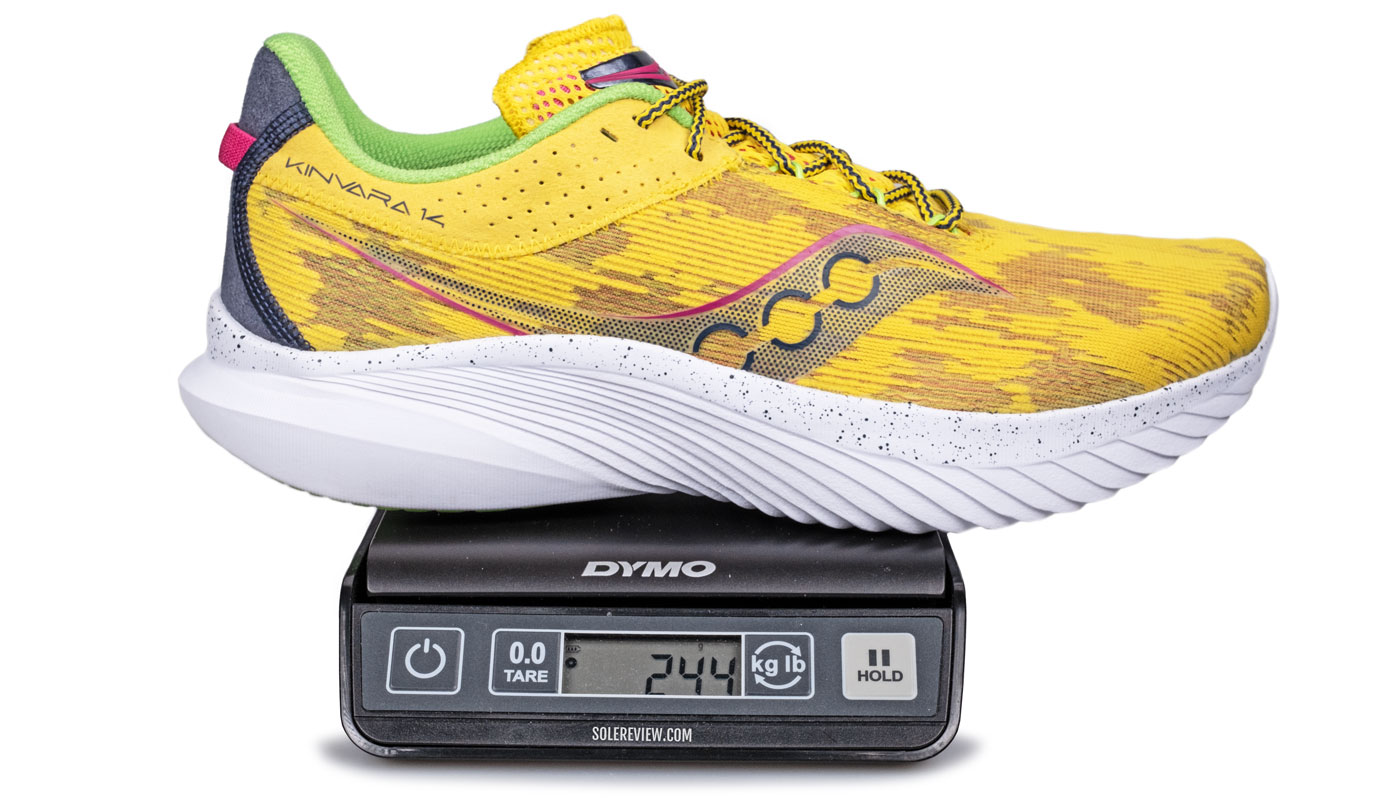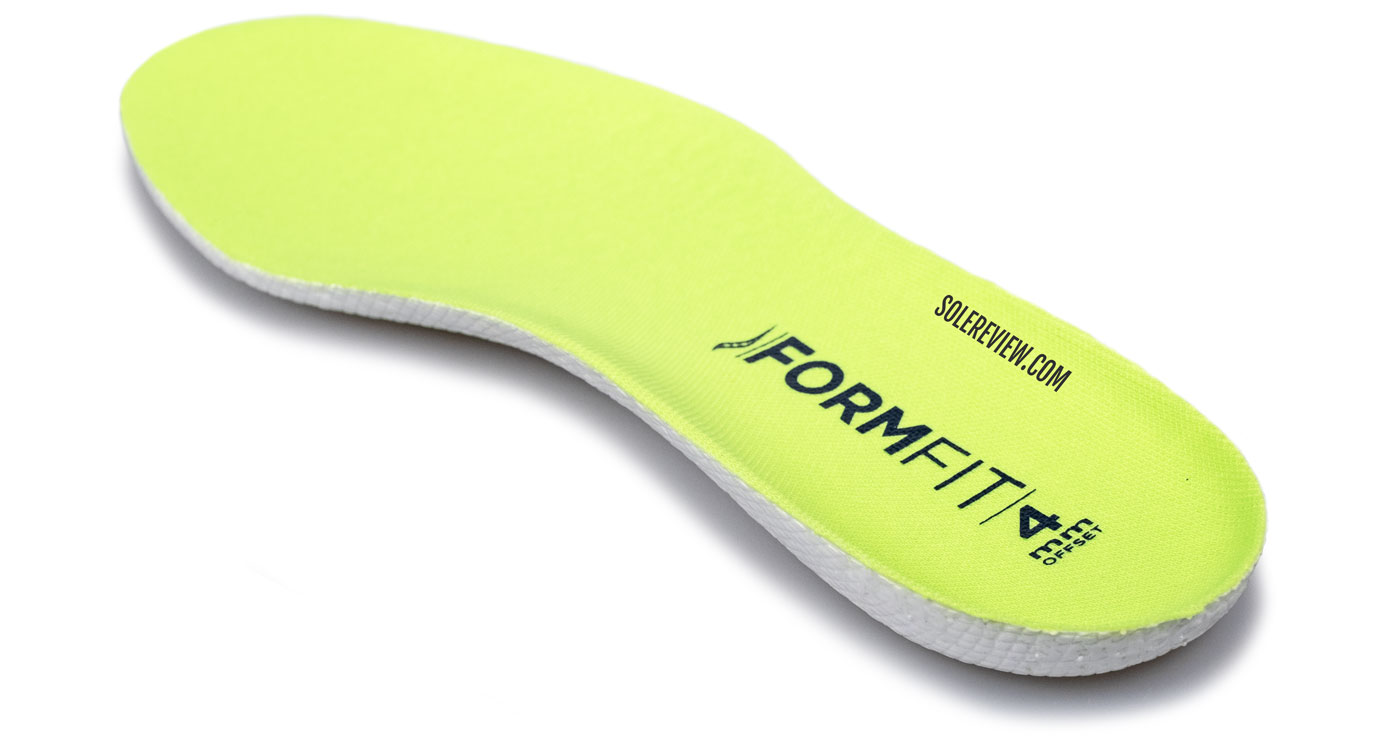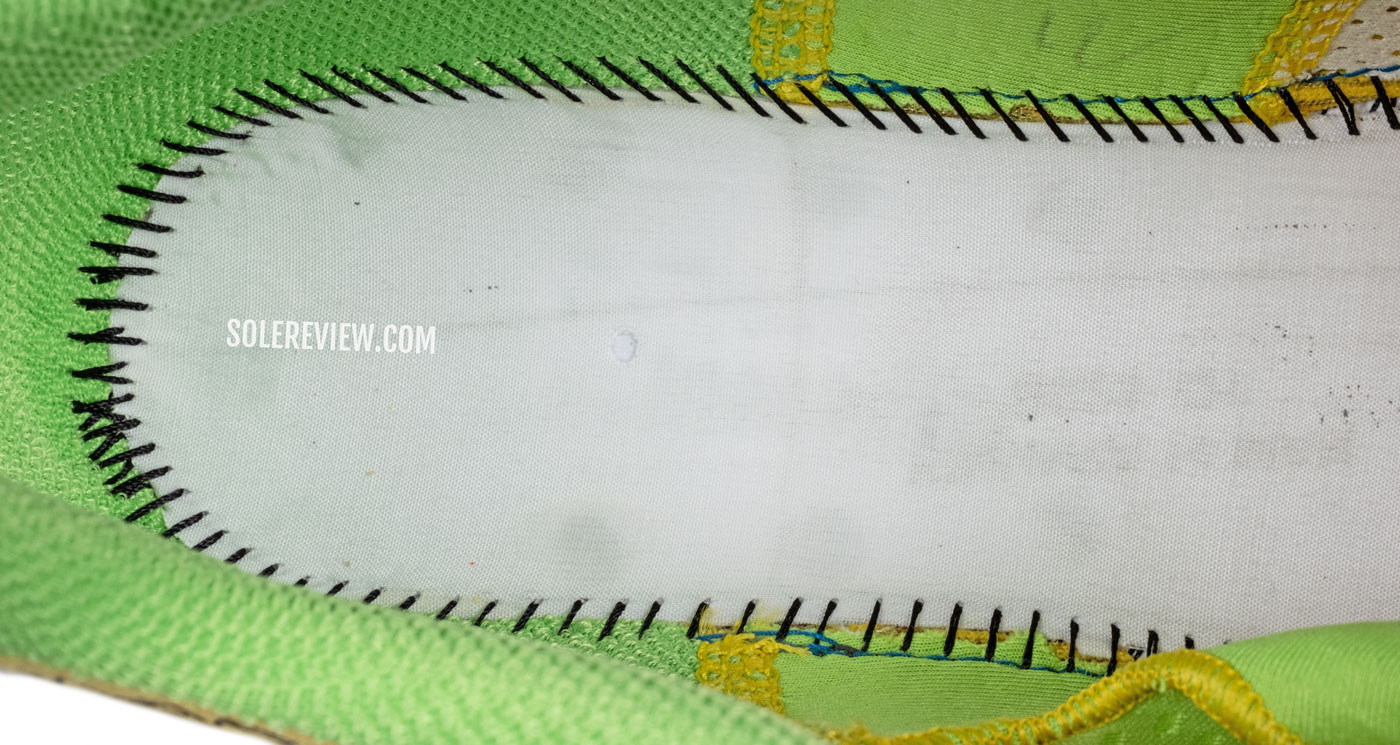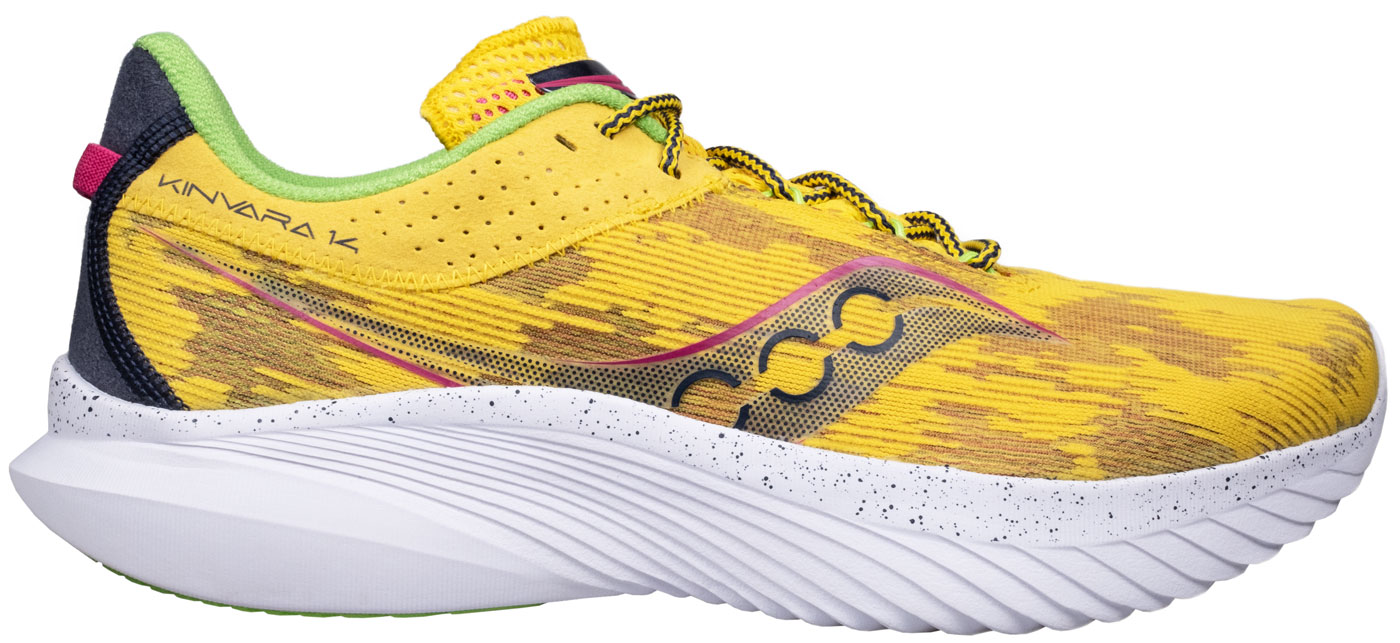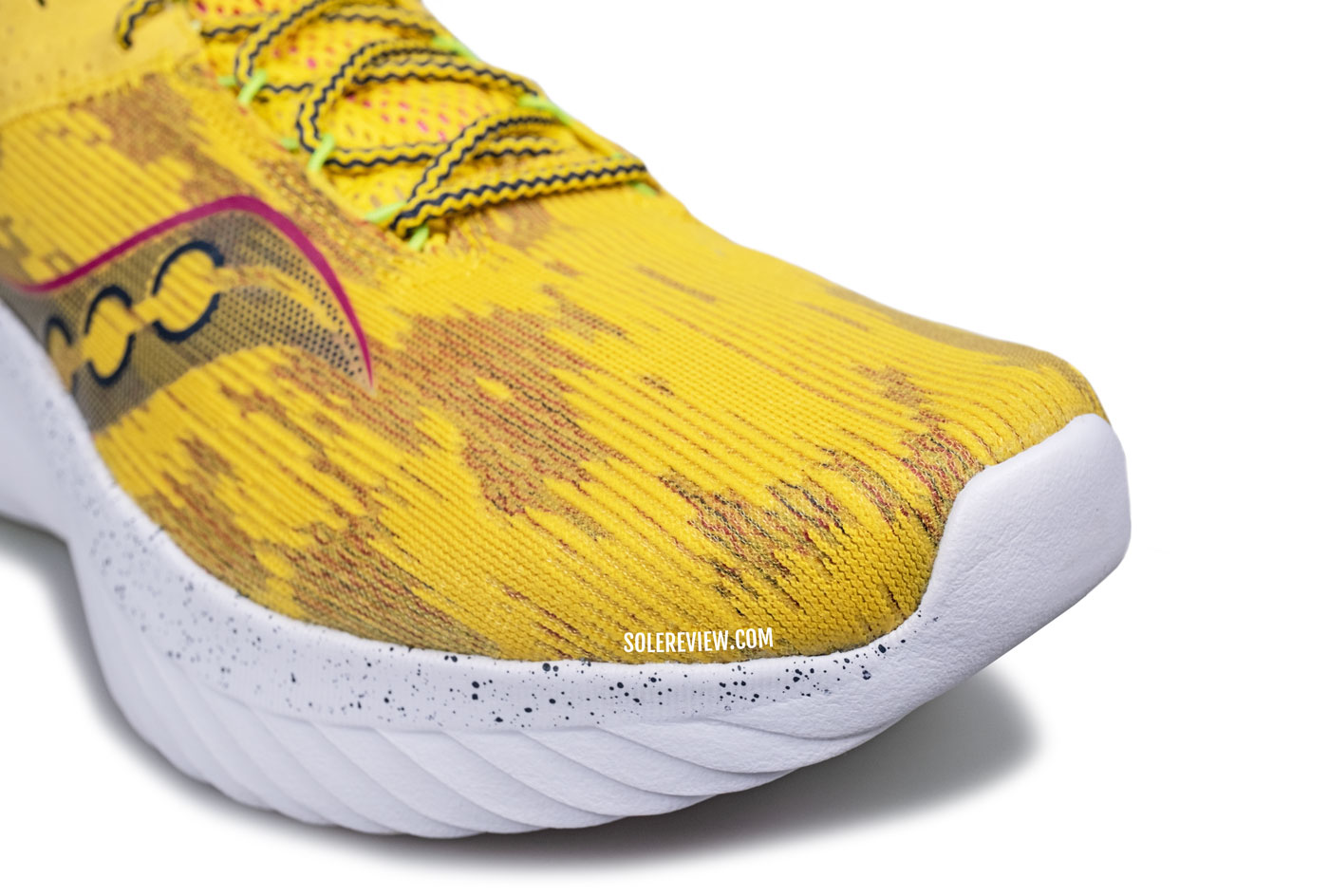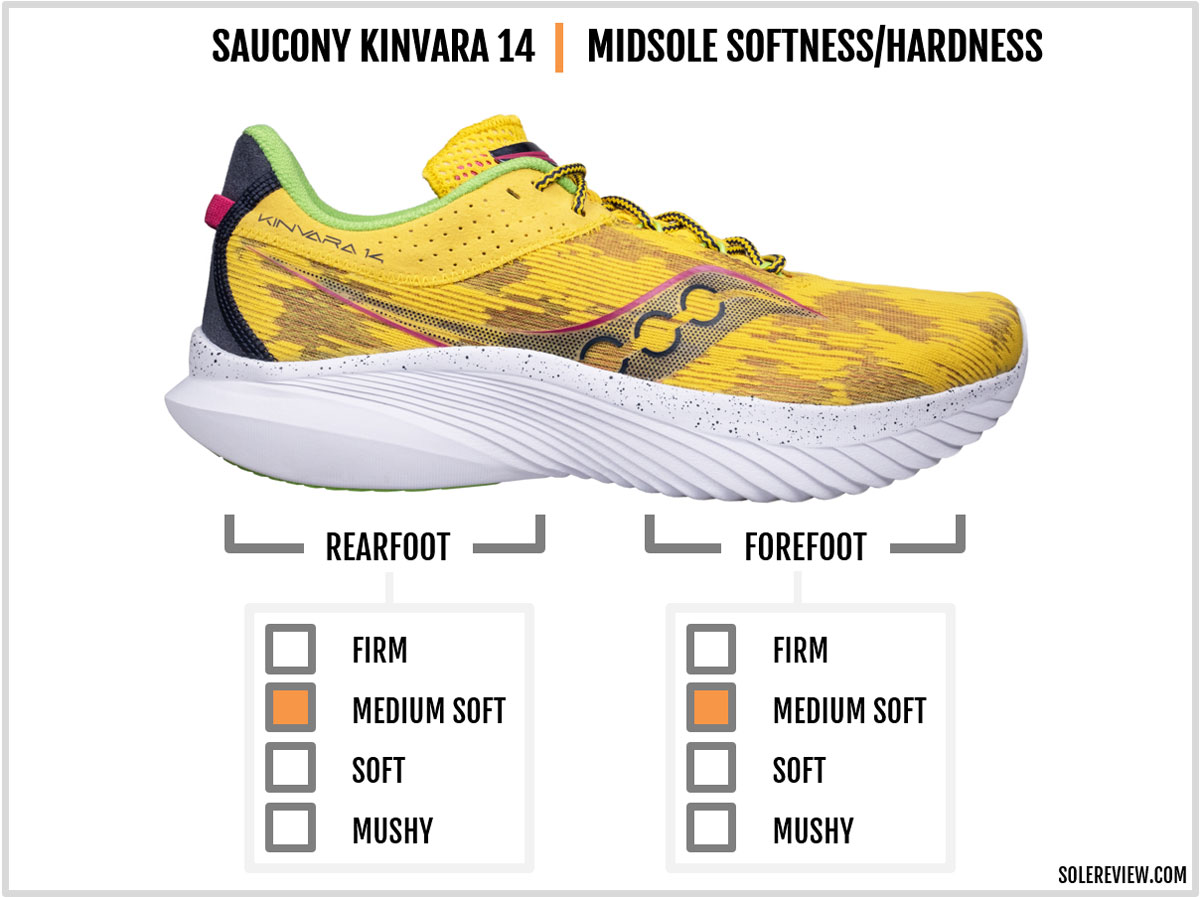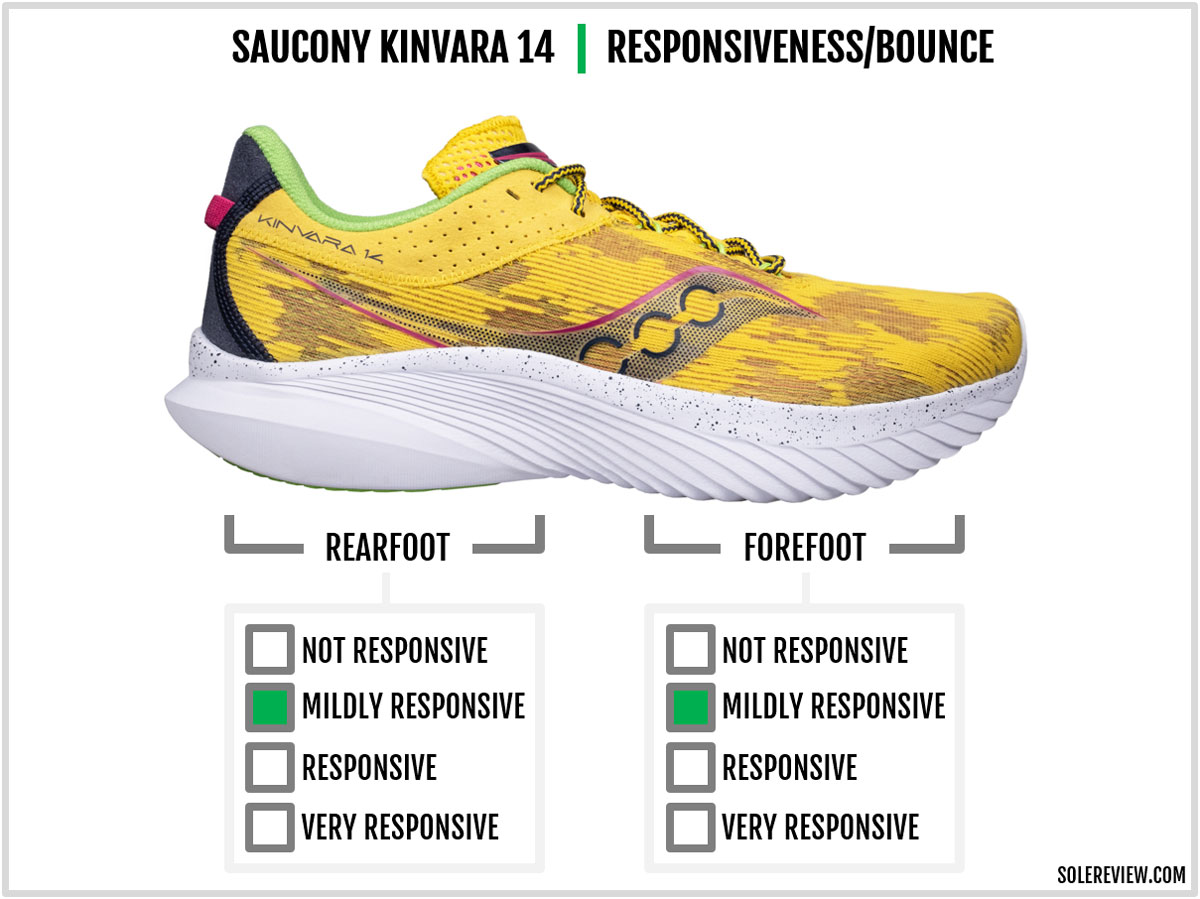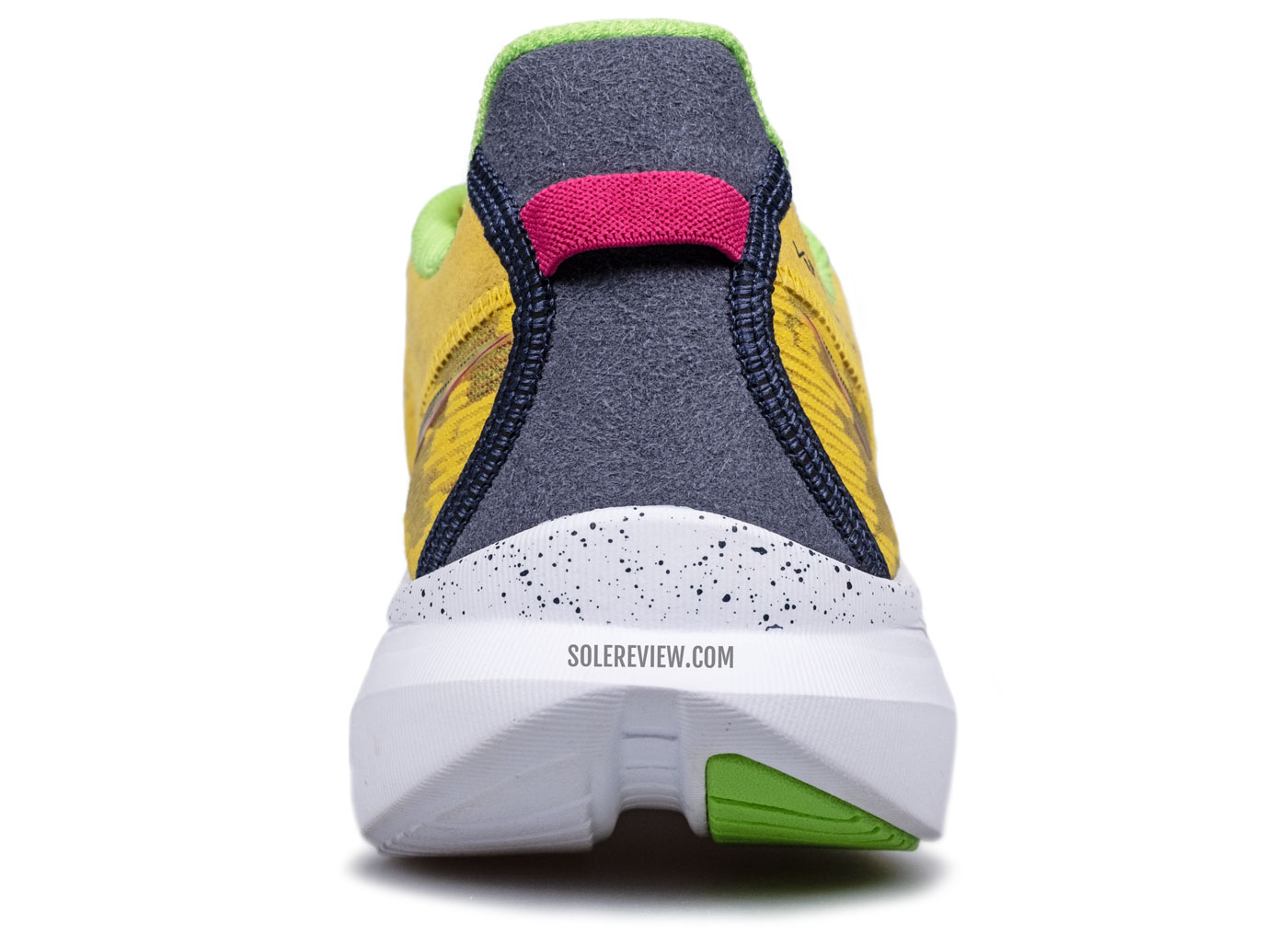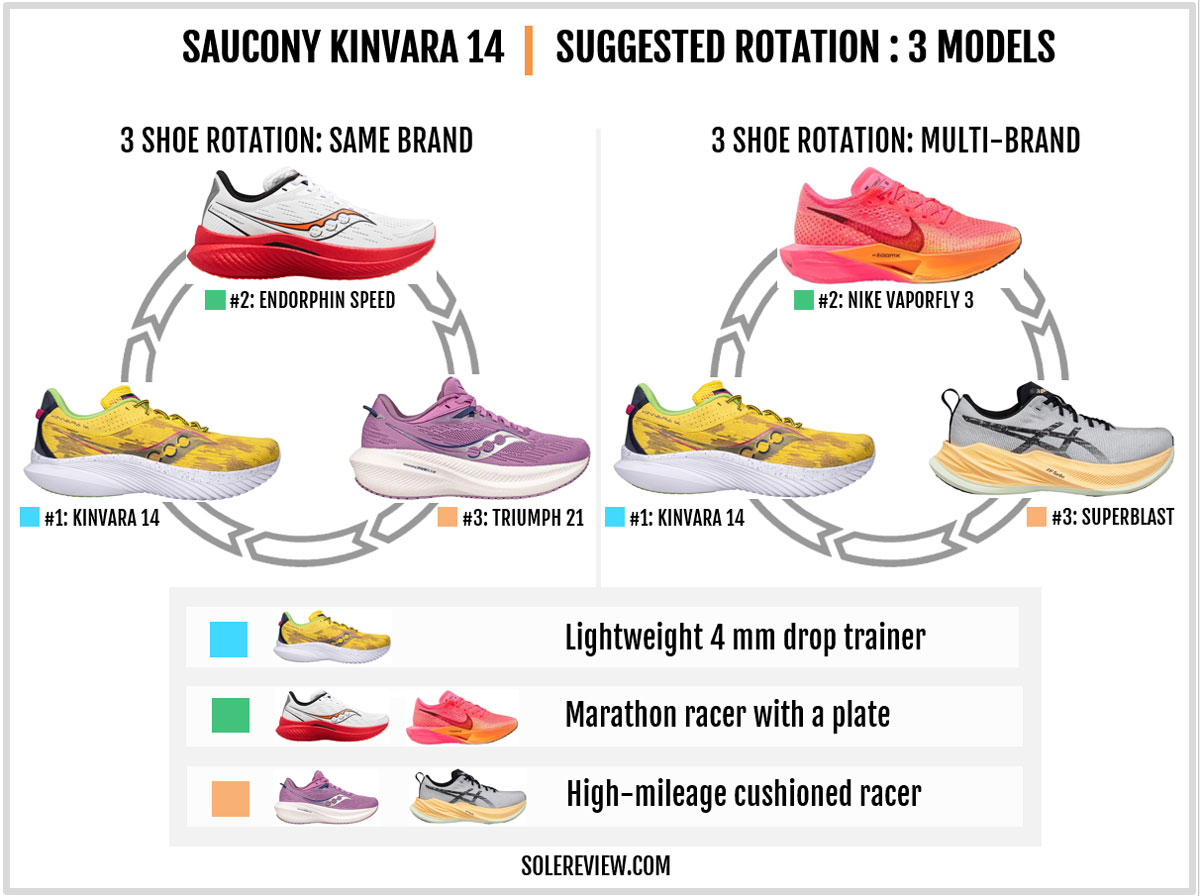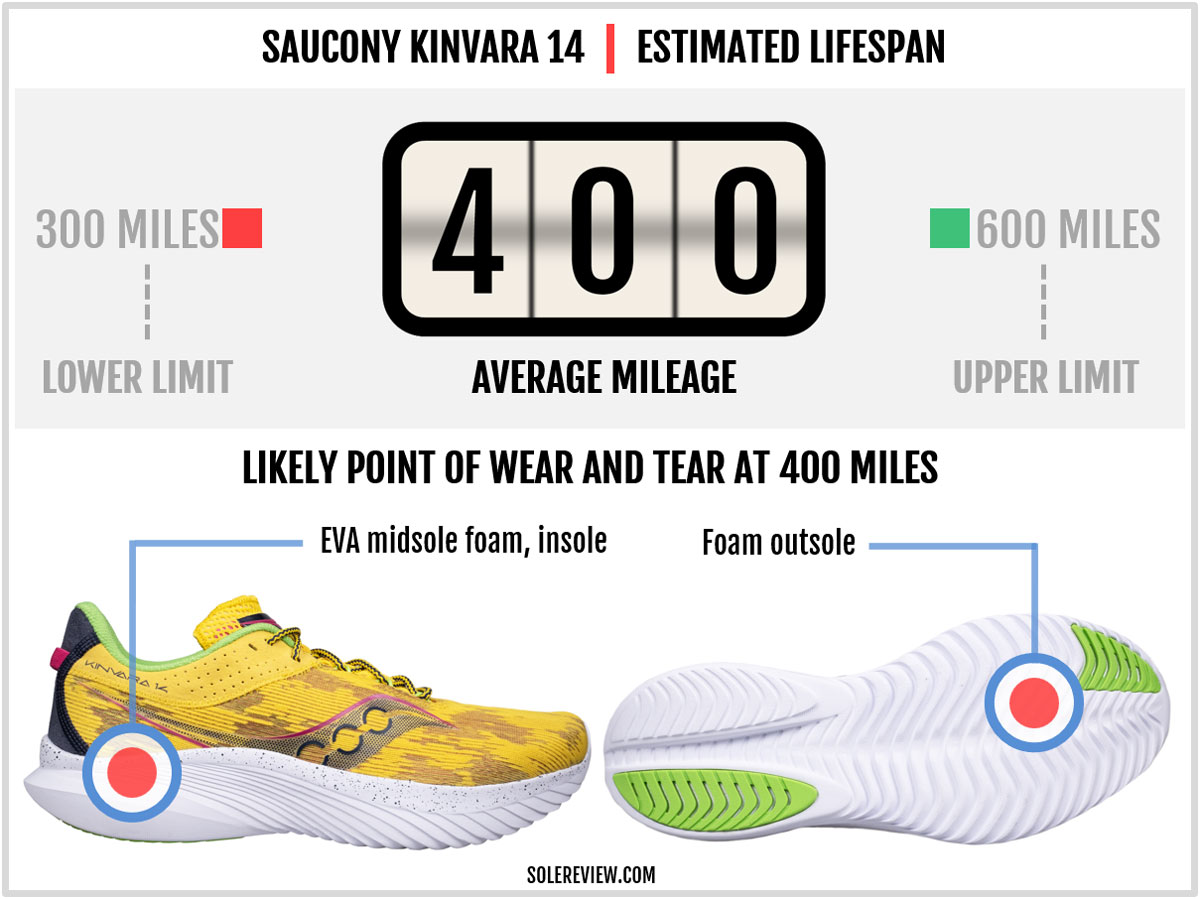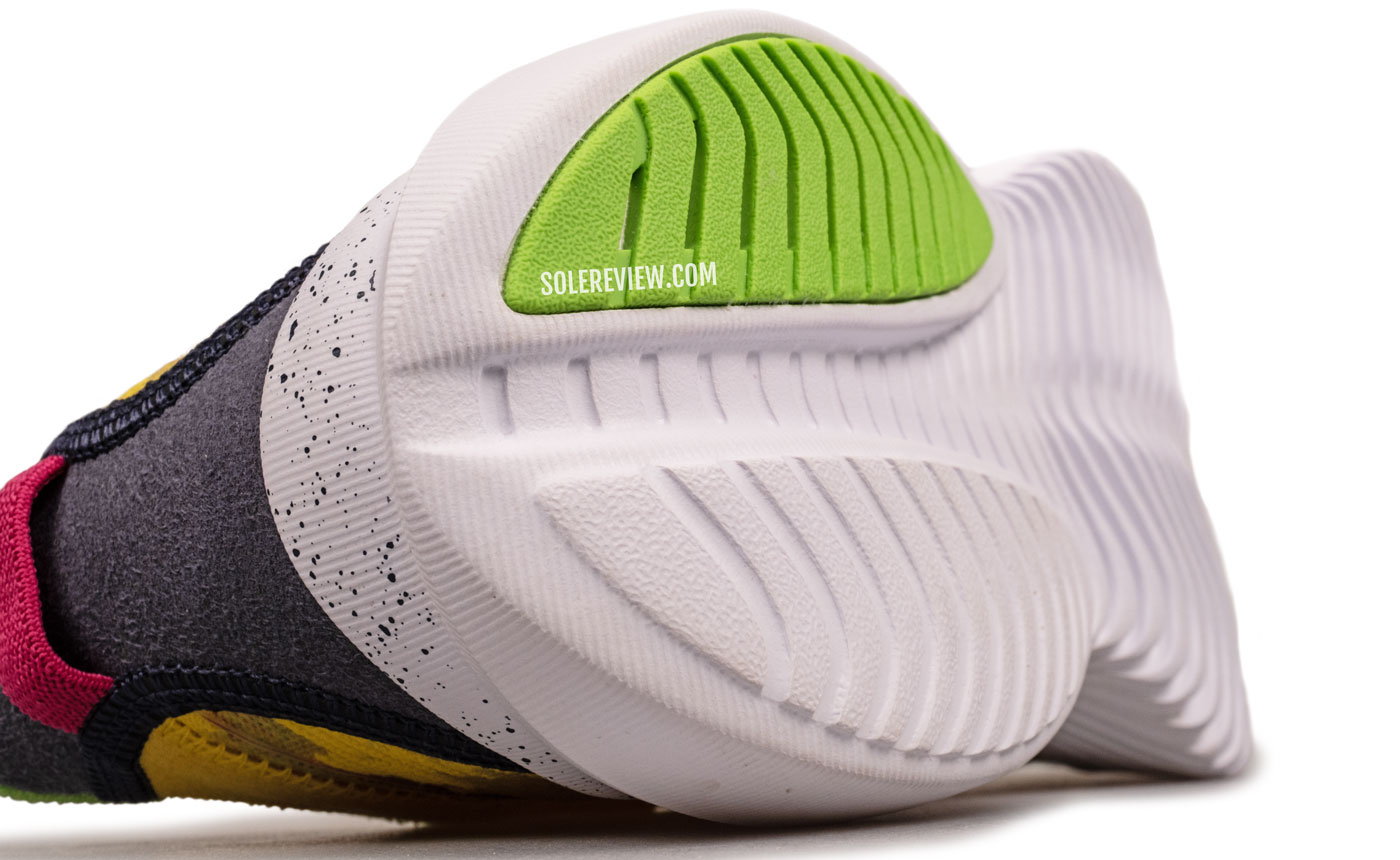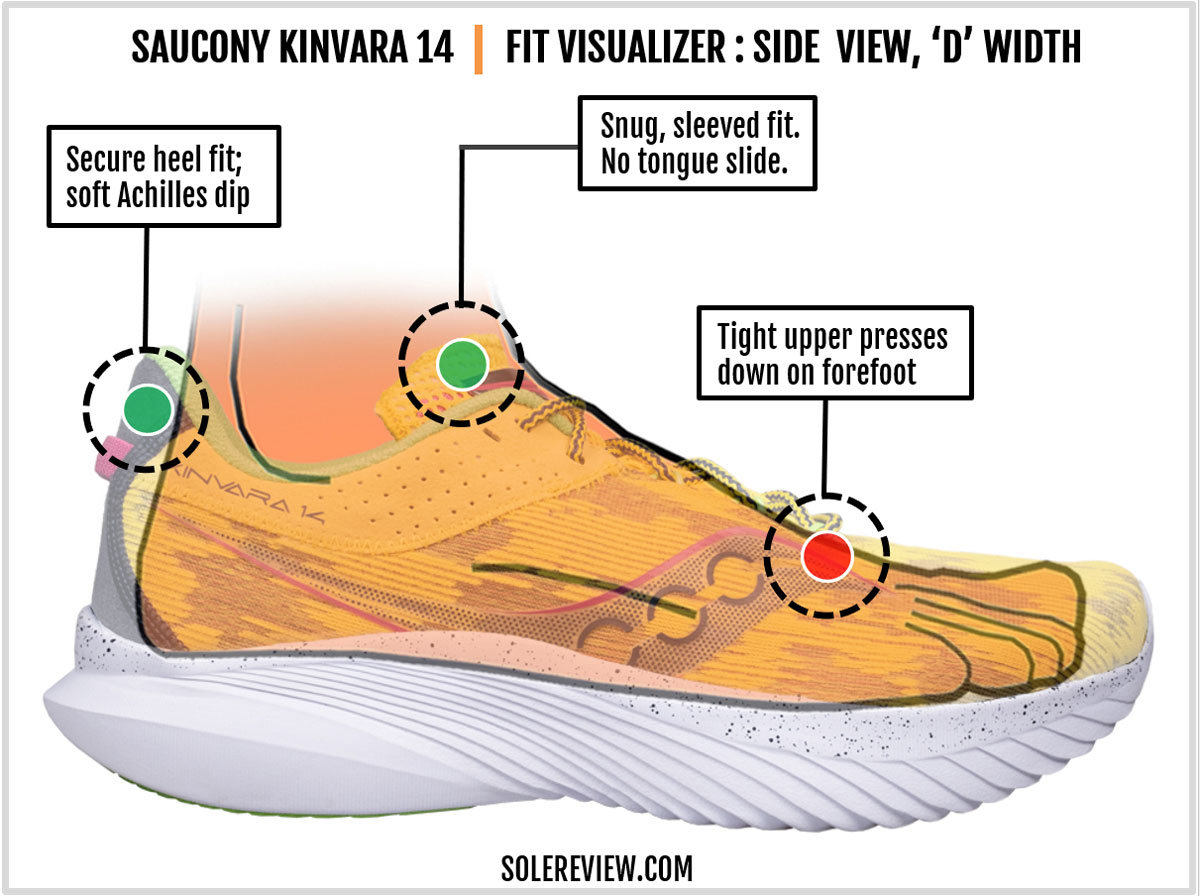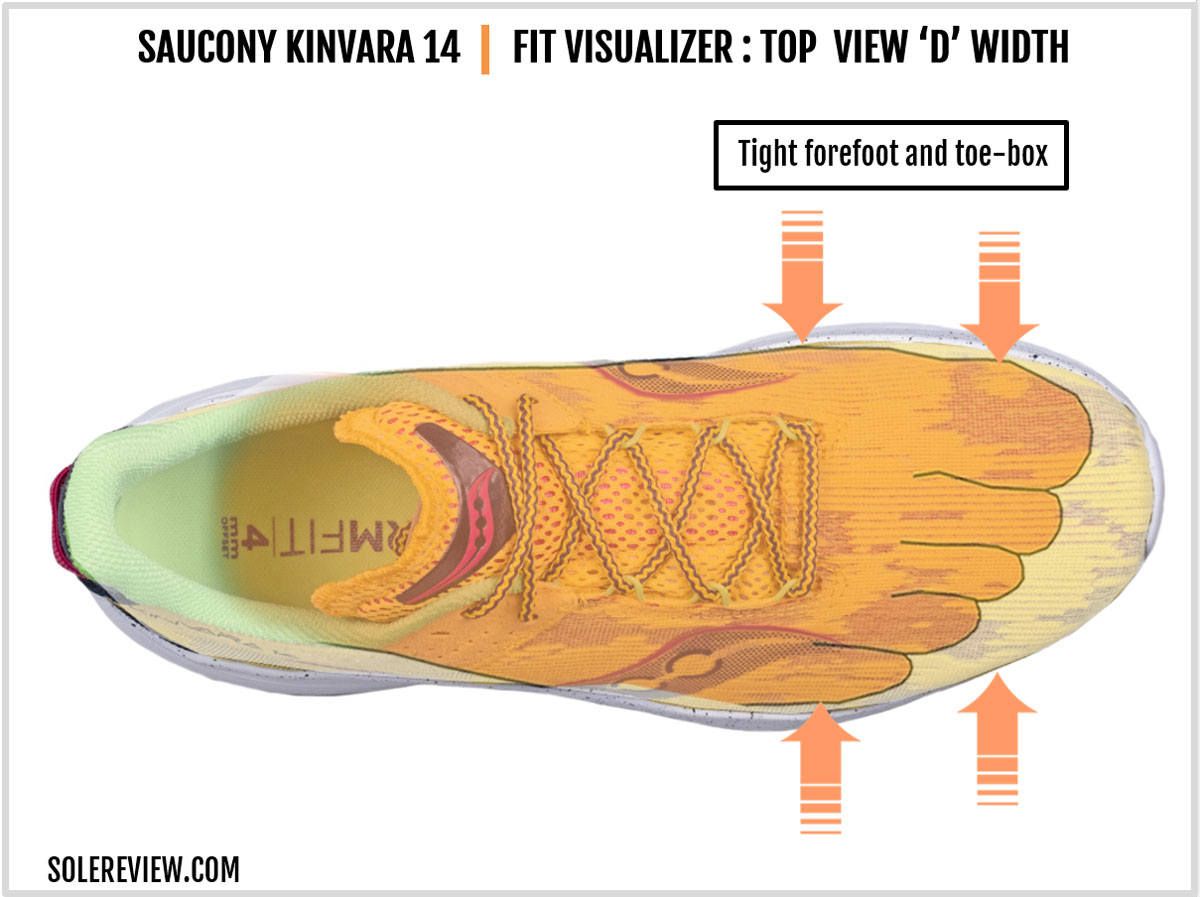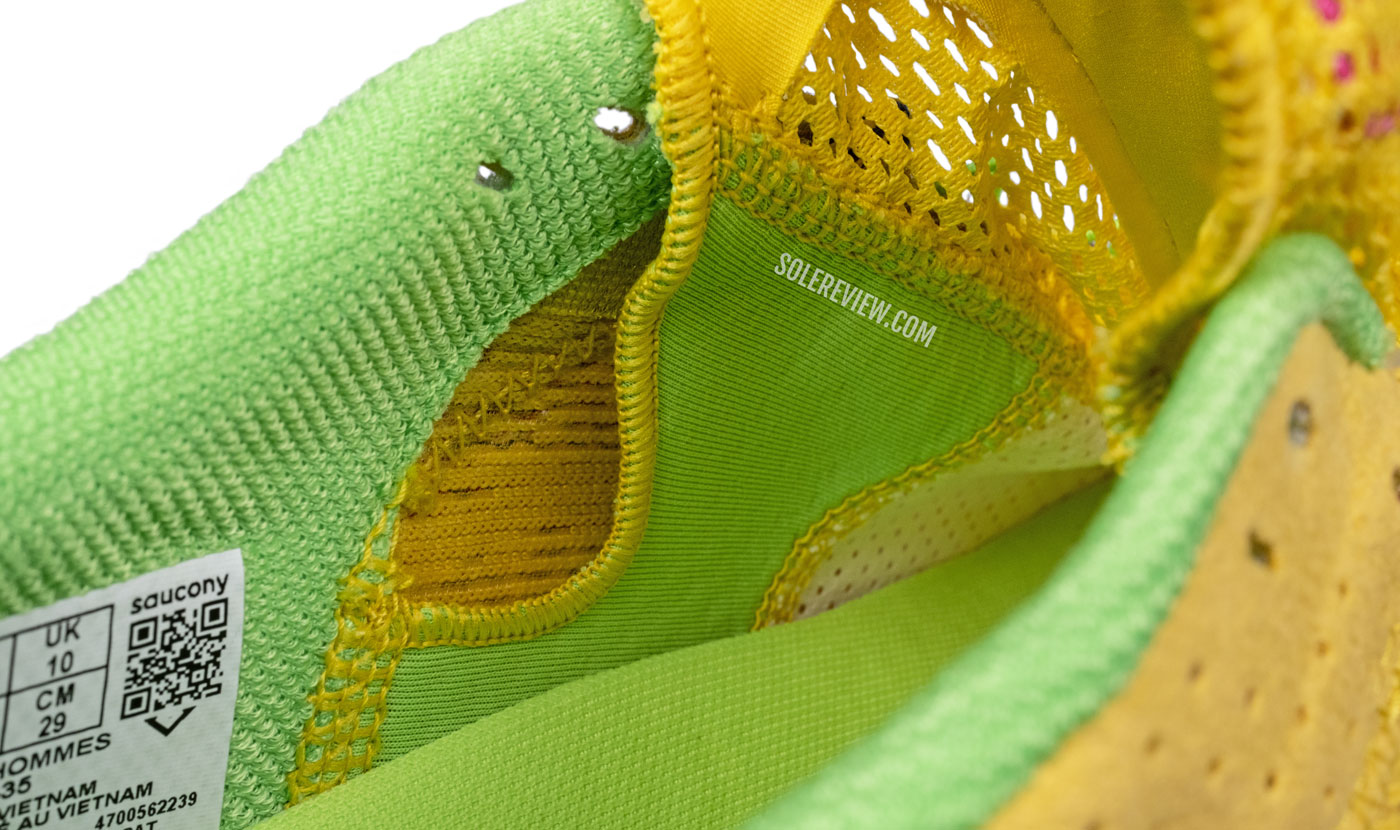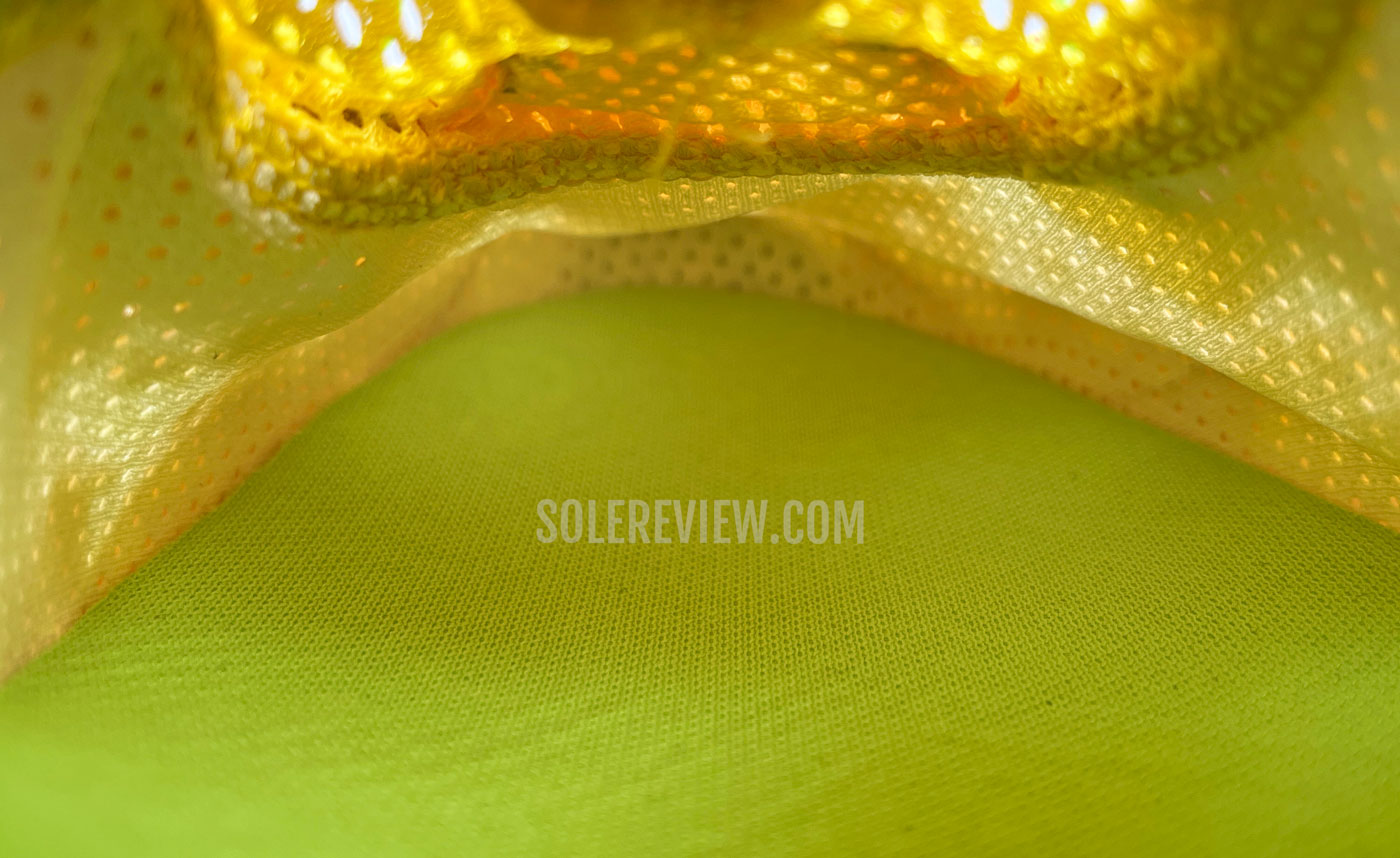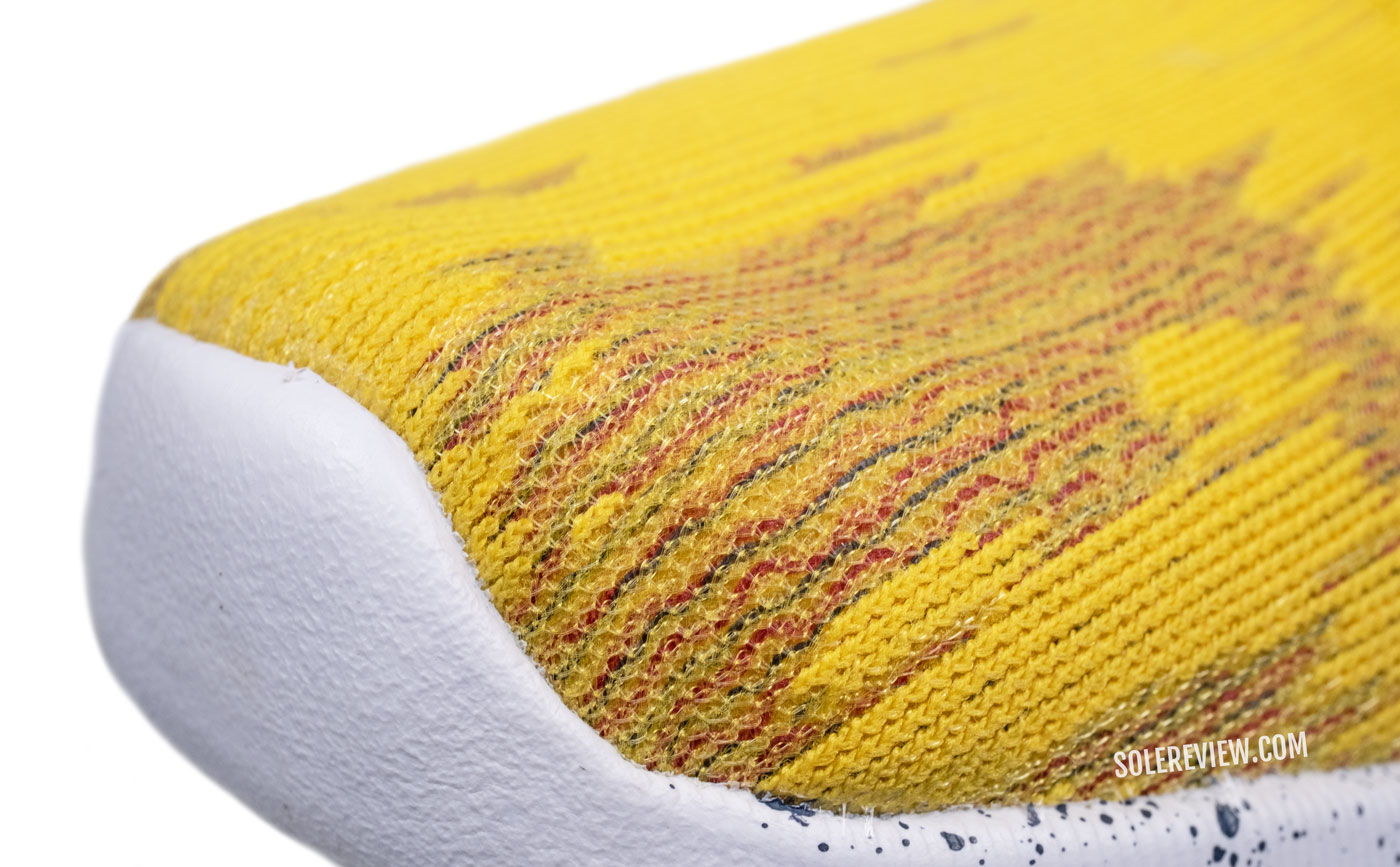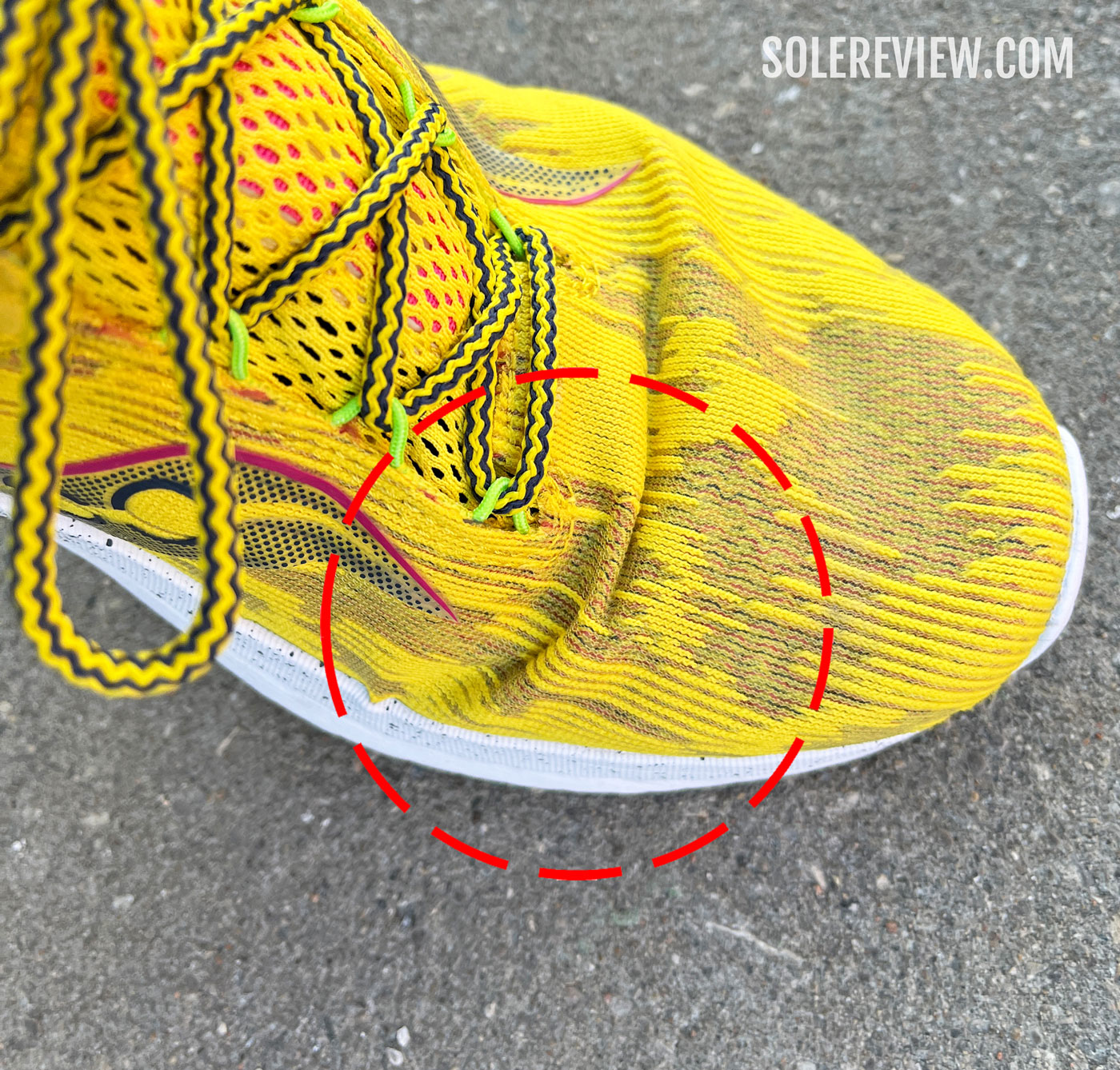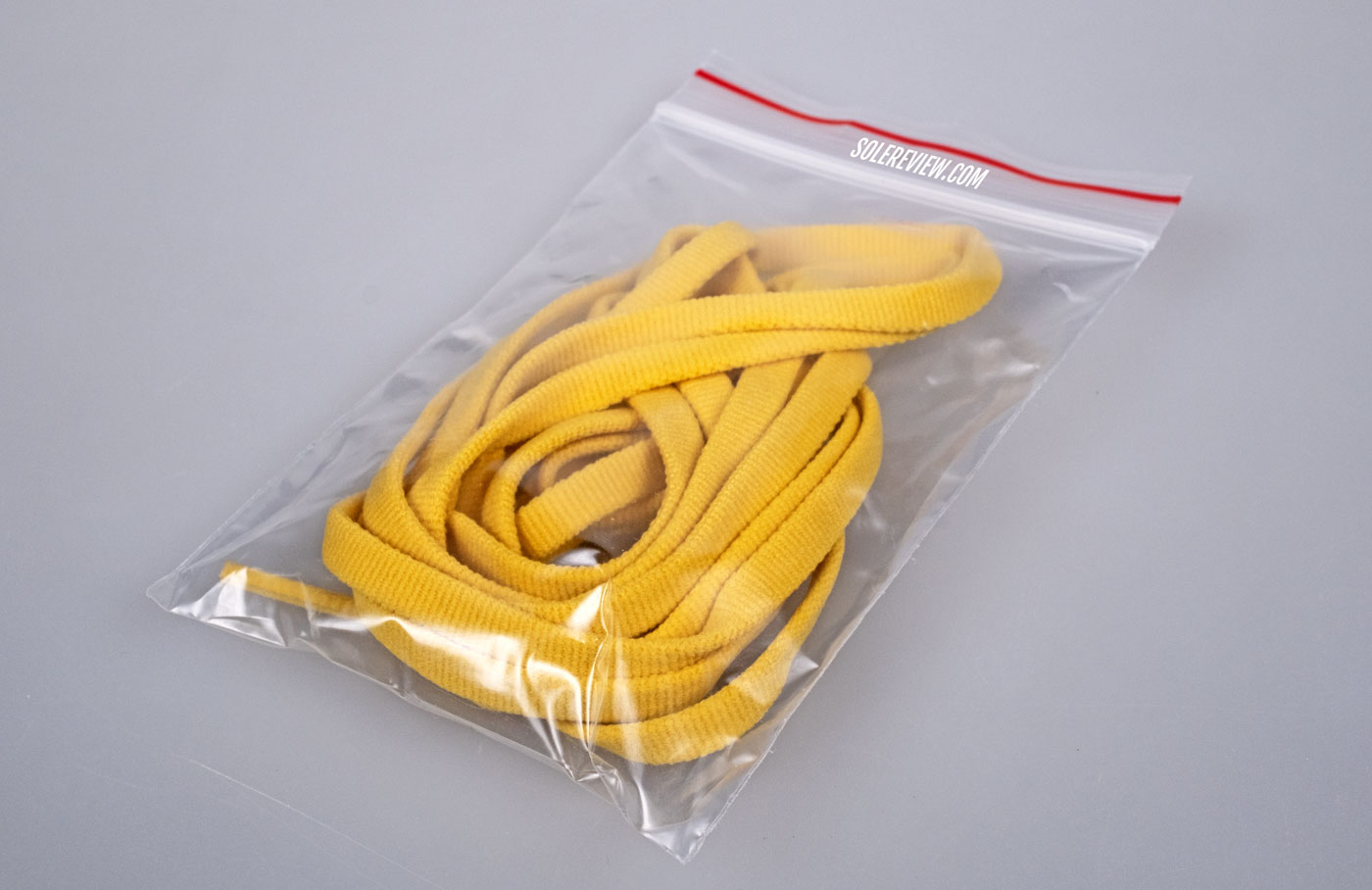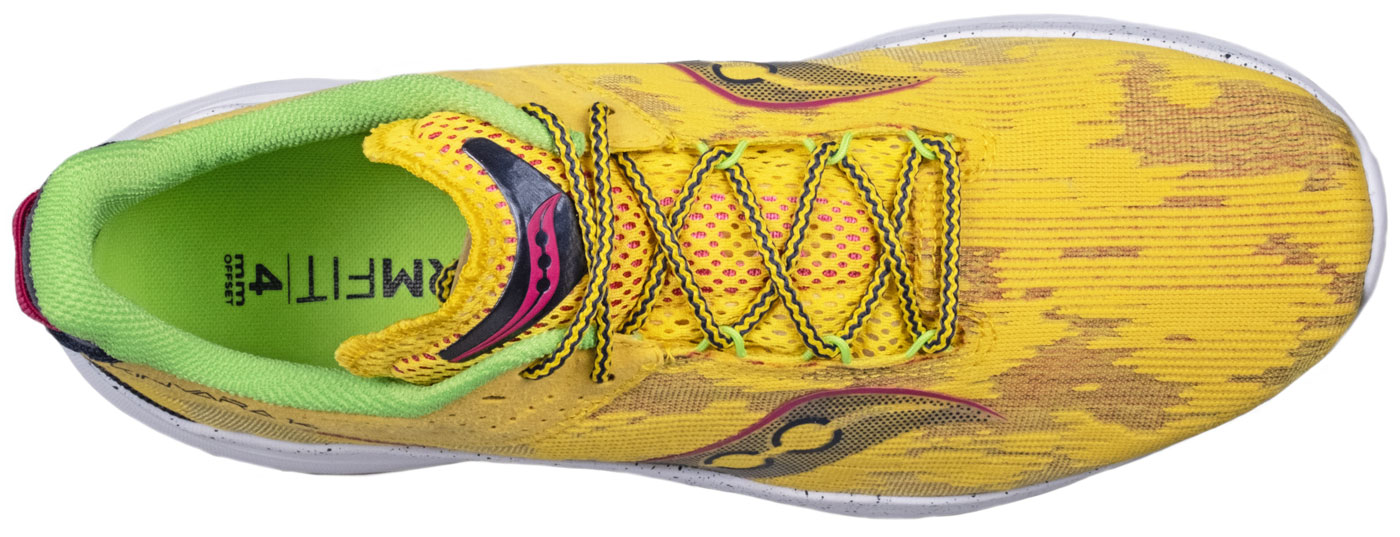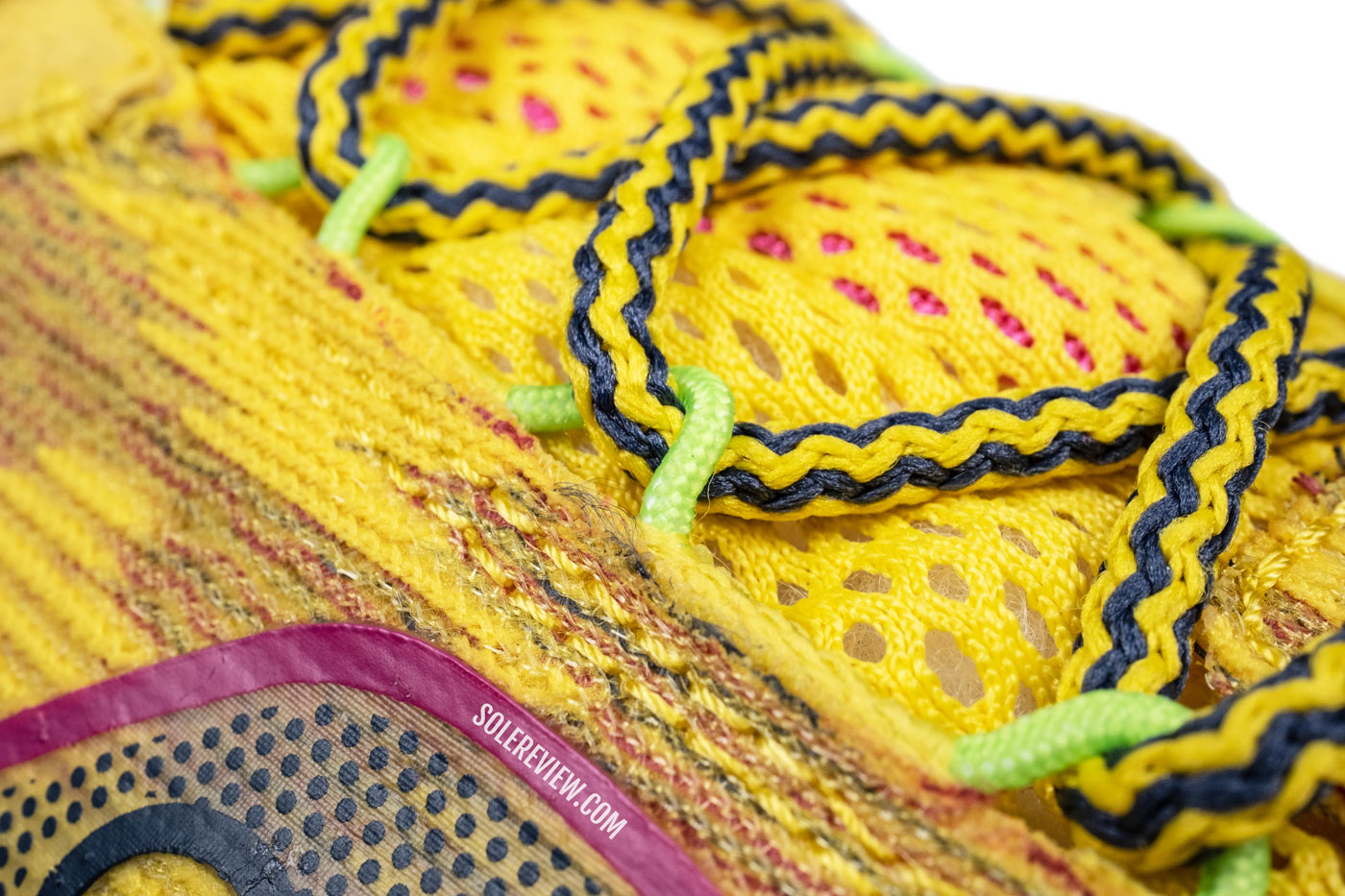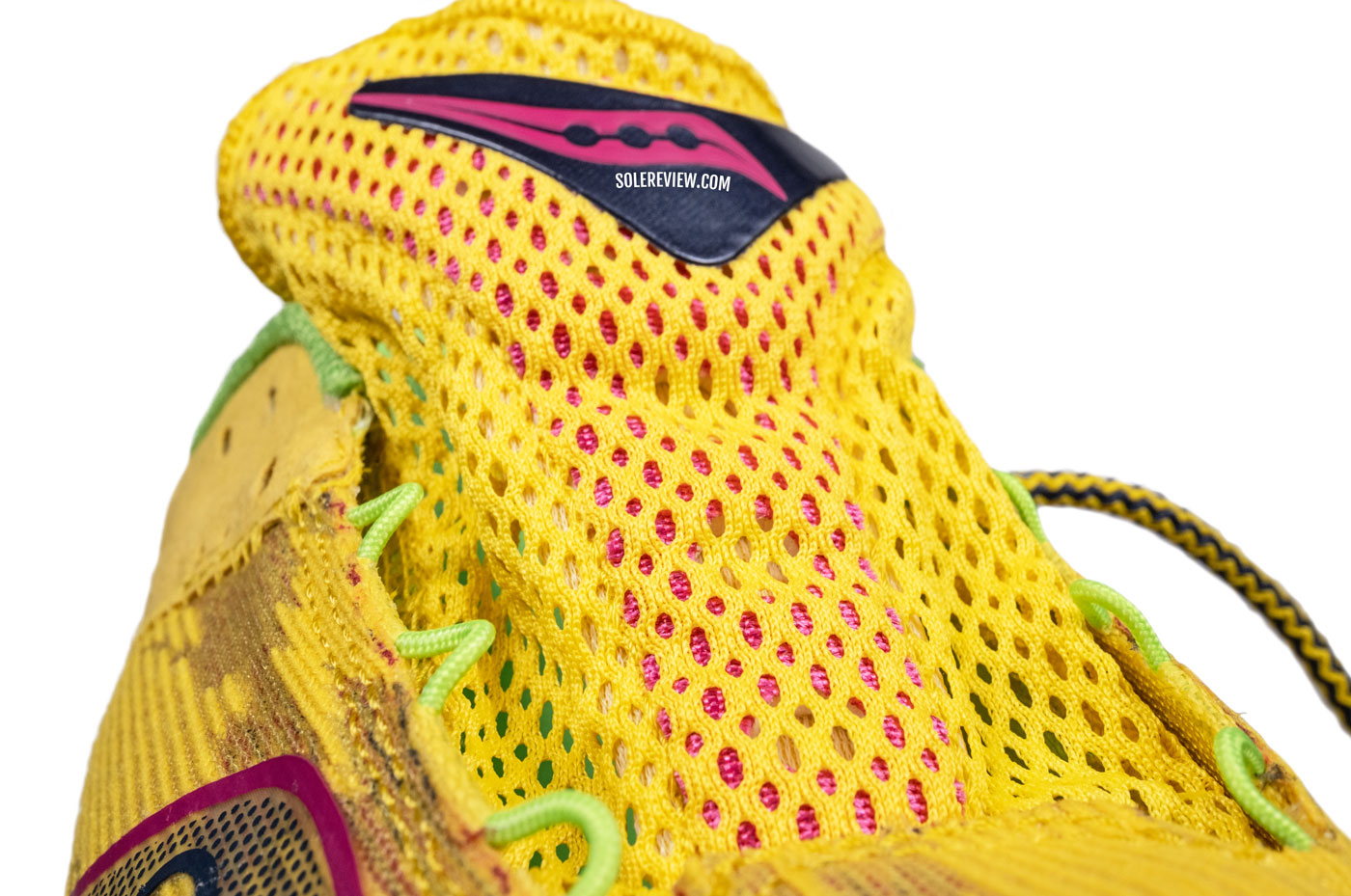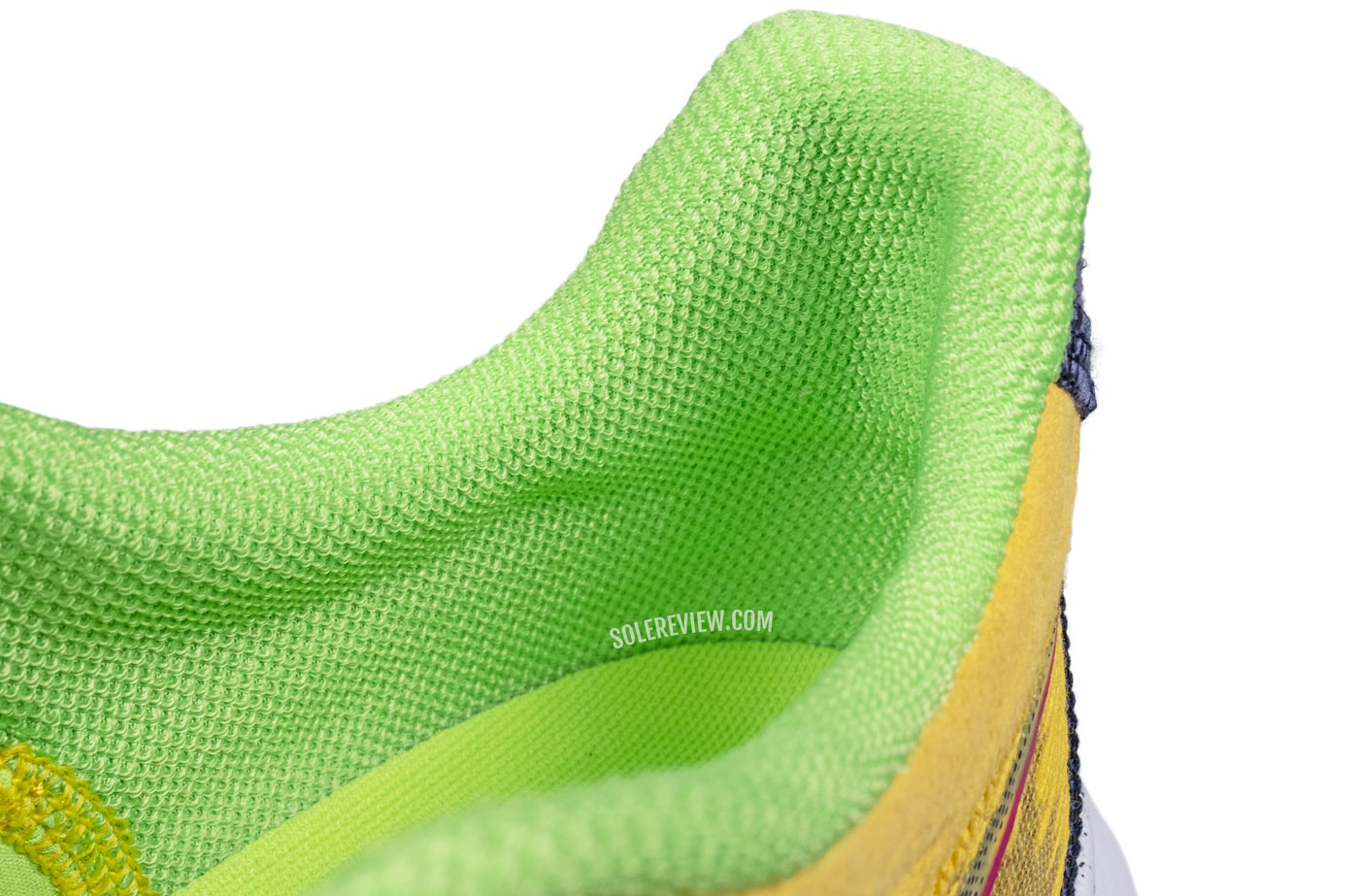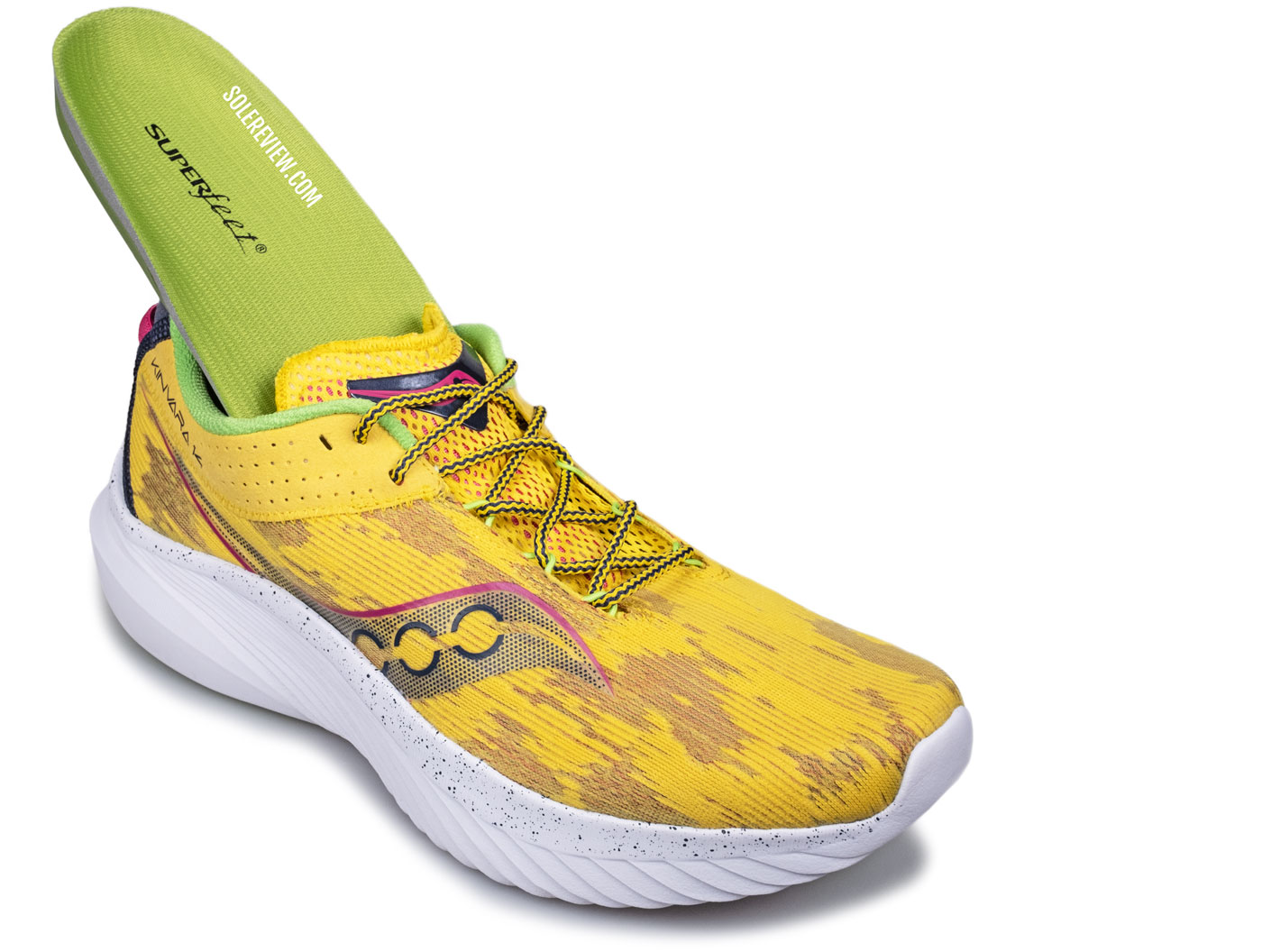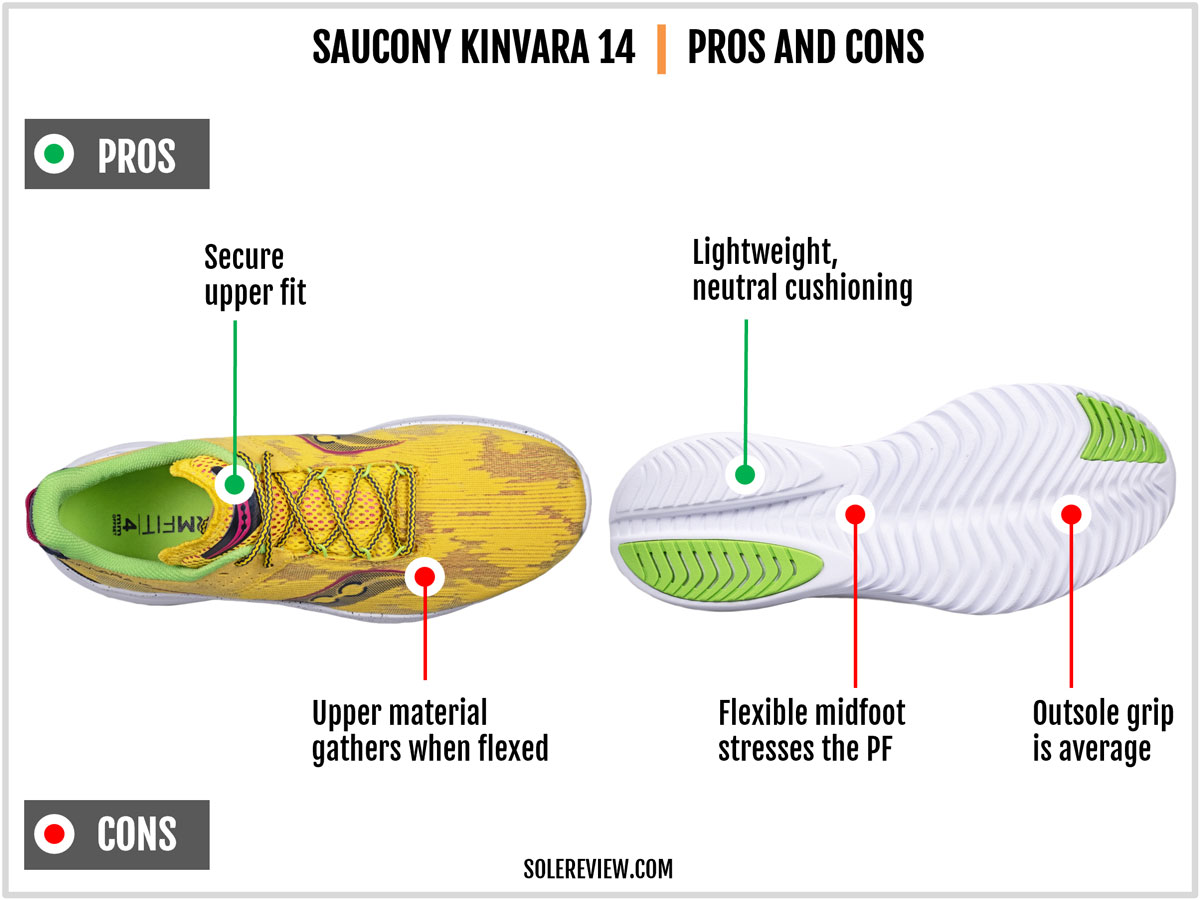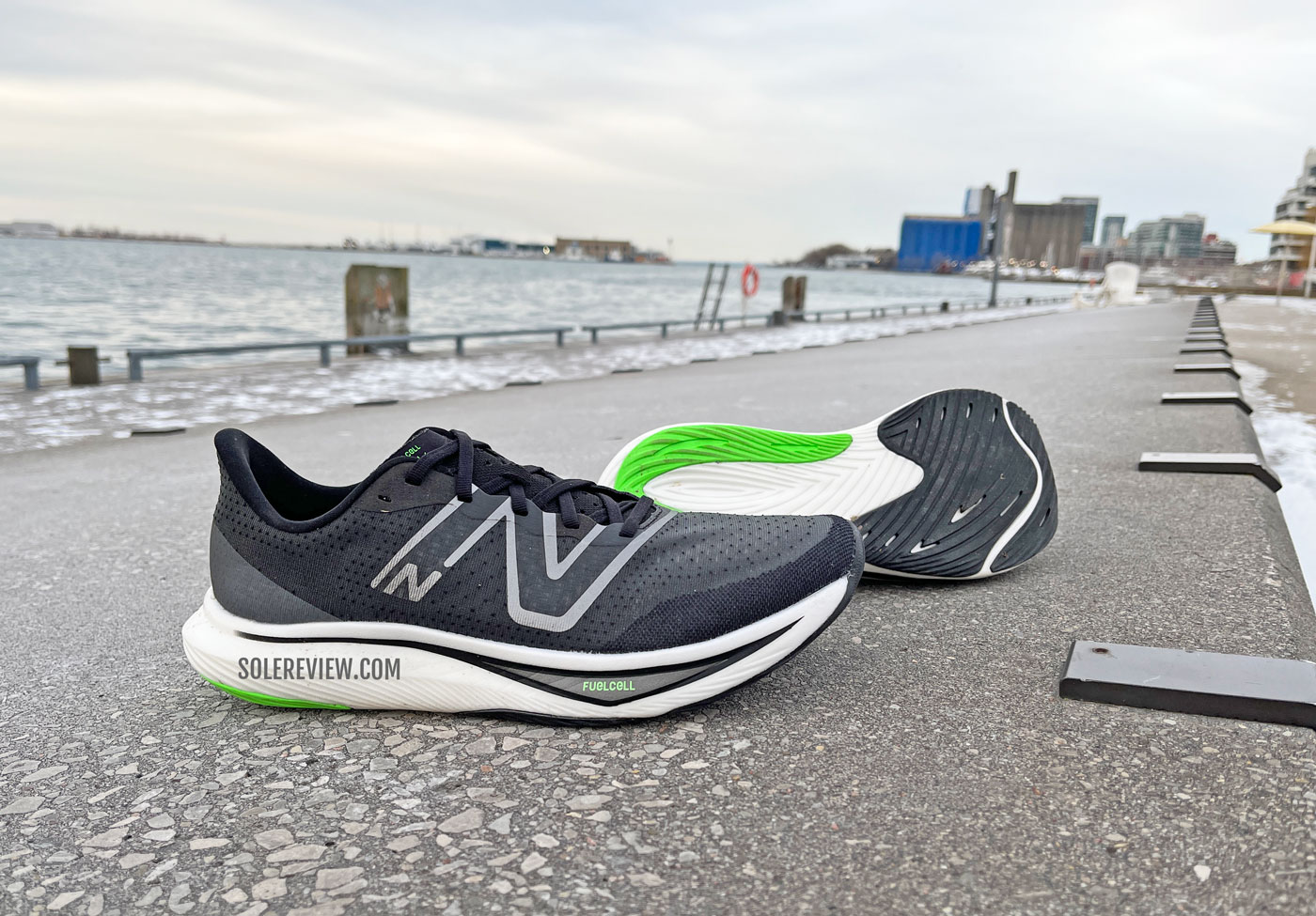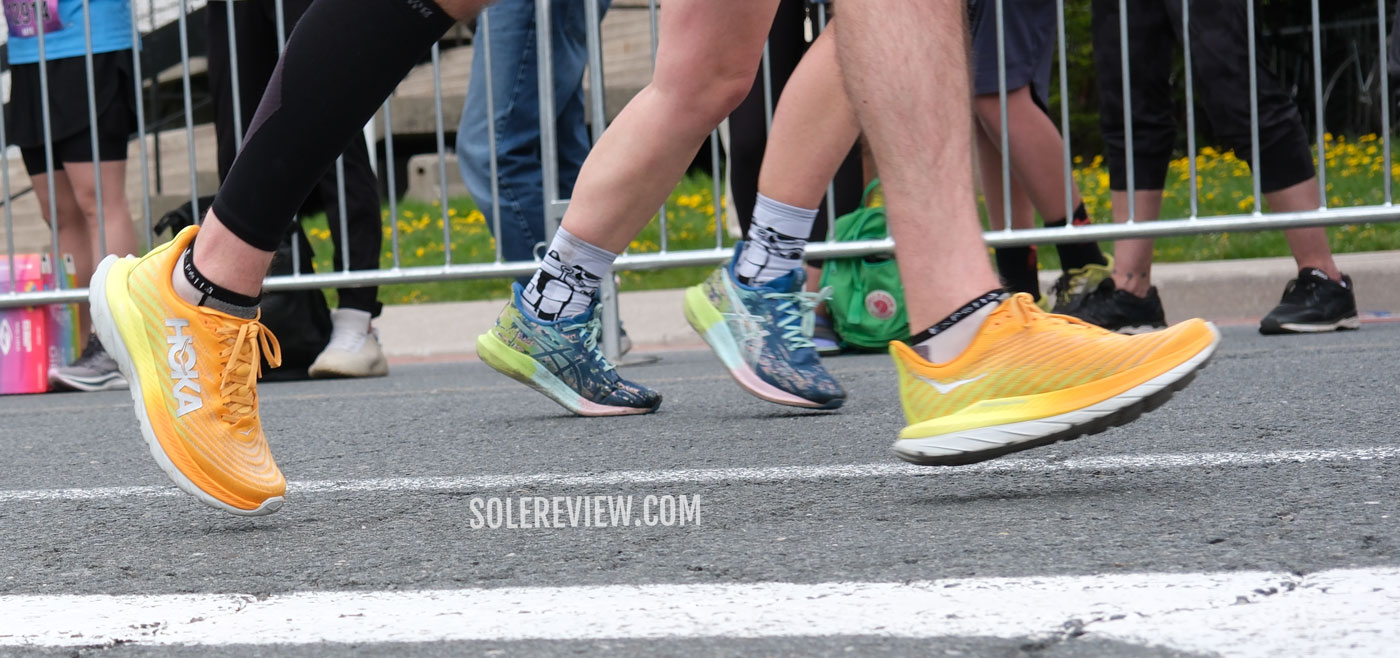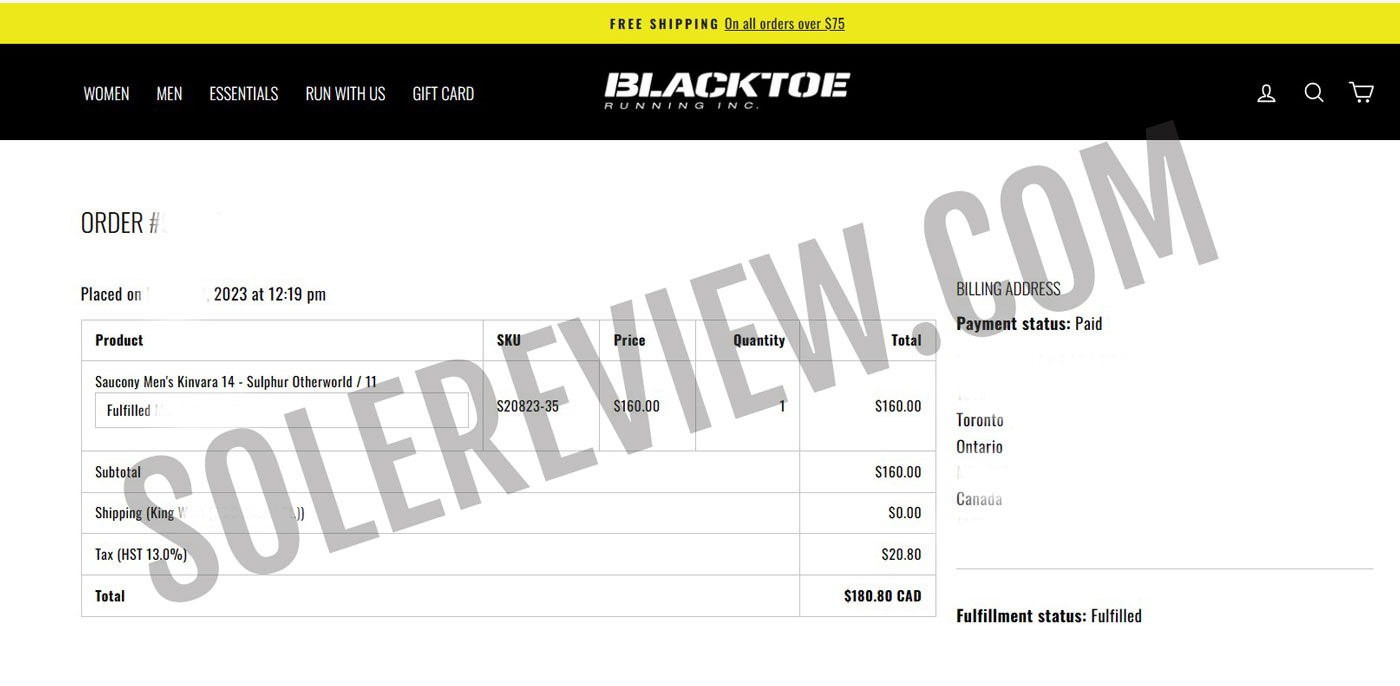
For this review, Solereview paid the full retail price for the Saucony Kinvara 14. The amount is in Canadian Dollars.
In this review:
SUMMARY AND VERDICT
Avoid the Kinvara 14 at all costs, even if you’ve been a long-time follower of the series. We’re dead serious. Buy the Kinvara 13 instead, or an alternative like the New Balance Rebel 3 or adidas adizero SL.
This isn’t just a subjective ‘Kinvara goes against its ethos’ opinion. The Kinvara’s irrelevance and deviation from its brief is the least of its worries; the Kinvara 14 has a serious flaw that is a dealbreaker in the literal sense.
It all began with a dull soreness under the foot. More specifically, the plantar fascia. At first, we didn’t know what to make of it. But this wasn’t the usual case of rogue midsole edges poking the arch, or a misaligned internal saddle creating a hot spot.
Then one day, it just clicked. The stiffer-than-before rocker forefoot. A slimmed-down, less supportive forefoot. An all-foam midsole with no shank or plate under the midfoot.
Put all these pieces together, and the midfoot becomes the most flexible part of the midsole. Of all the flaws a running shoe can have, this is by far the worst.
This is not the same as a shoe with an ultra-flexible outsole (like the Nike Free, for example) where the forefoot and midfoot are equally flexible. Such ultra-flexible running shoes allow the foot to bend naturally.
The Kinvara 14’s midsole has a stiff forefoot and flexible midfoot. With the midfoot becoming the point of least resistance, the midsole applies unnecessary pressure on the Plantar Fascia – a thick band of connective tissue that connects the heel to the toes. A properly designed midsole should be easiest to bend at the MTP joint (ball of the foot), and not under the arch.
A midsole that’s easier to bend under the arch will stress the Plantar Fascia at a time (during pre-swing/toe-off) when it is taut and fully engaged. This is basic footwear 101.
Adidas has honed midfoot rigidity to an art form; the German brand takes no chances and will almost always use an LEP/Torsion shank or similar.
This isn’t to say that adidas doesn’t make bad shoes. As a shoe reviewer, the slippery 2014 adidas Pureboost Reveal comes to mind. But even that shoe had enough sense not to make the midfoot the most flexible part of the shoe.
It took more than a few days to understand the reason, because most modern running shoes seldom have egregious faults. One does simply not expect the midfoot to be the most flexible part of the shoe. And certainly not in 2024.
The last time we remember a shoe doing this was in 2015 when we reviewed the Asics 33-DFA. The 33 DFA covered the forefoot with rubber but kept the midfoot exposed and unsupported. There was no rocker on the 33-DFA, but the stiffer forefoot made the midfoot the most flexible area of the shoe.
But we’ll cut Asics some slack, as the 33 series products in 2015 were a hurried response to the then-rising trend of minimalist running shoes. Saucony, on the other hand, has no such excuse – especially when the Kinvara 14 was built on the back of a very well-designed Kinvara 13.
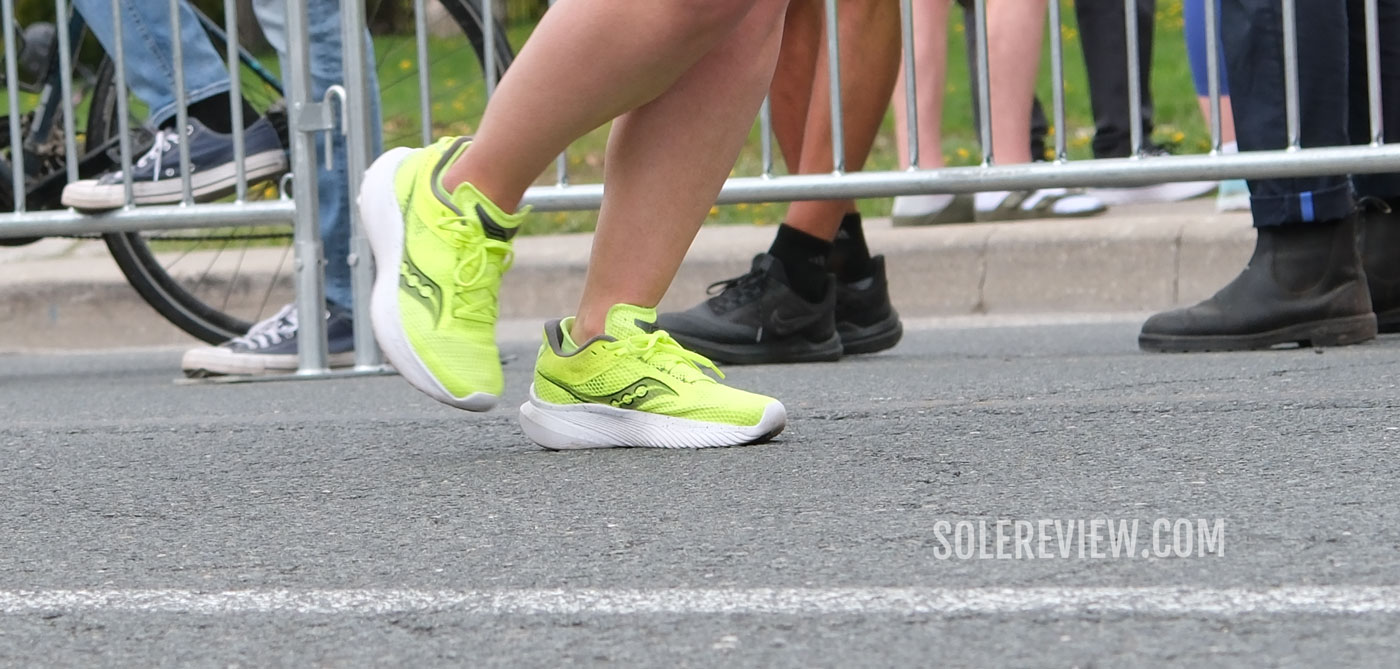
If you’re a healthy, injury-free runner who regularly puts on road miles, the Kinvara 14 will likely not cause serious harm. But why assume that risk at all?
So what are the broader implications of the Kinvara 14’s terrible design?
First, the half-decent news. If you’re a seasoned runner in good shape who puts in at least 15 miles a week, then running 5-10 K in the Kinvara 14 now and then is not going to wreck your PF. Well, at least not immediately.
It’s bad news if the Kinvara 14 gets on the feet of beginner runners or folks who are recuperating from PF injuries.
In another scenario, the Kinvara 14 may be purchased by non-active customers just because they found a good deal. Let’s say an overweight individual with a sedentary lifestyle buys a marked-down Kinvara 14 from a local TJ Maxx/Marshall, or an in-store markdown. In such cases, the lack of support may result in potential injuries. This could amount to anything between an inflamed Plantar Fascia and heel pain.
Do you know what would be worse? A Kinvara 15 with the same midsole as the 14. Now that would be a new low.
If the Kinvara 15 is based on the same midsole as the Kinvara 14, we’ll have plenty to say in that review. It beggars belief that the same brand that gave us the excellent Endorphin Speed and Saucony Triumph green-lit the Kinvara.
Then, there’s the subject of the Kinvara 14’s irrelevance.
Many runners would be familiar with the New Balance Zante’s popularity a decade ago. It had a successful run of around three years, and then faded away, as many running shoe models do.
Today, the Zante might pop up in a conversation now and then, but nobody misses it. And you know why? Because the Fuelcell Rebel took its place.
So while New Balance killed the Zante name, the product concept – or essence – lived on. Just like the Zante, the Rebel 3 is a lightweight trainer that’s quick enough for tempo training and Fartlek, but comfortable enough for 10K. The Rebel is a reimagined Zante with modern materials, and is relevant for the times we live in.
If Saucony kills the current-gen Kinvara, very few people will miss it. There are a few reasons for the Kinvara’s irrelevance:
1. Consumer expectations have changed. A barebones lightweight trainer with an EVA midsole doesn’t cut it anymore, and certainly not at $120.
2. There are superior alternatives. For just $10 over the Kinvara, the New Balance Rebel offers a vastly superior experience while addressing a similar product need. The adizero SL is priced the same as the Kinvara 14 and offers a lot more while staying true to its goal. We also view the Hoka Mach 5 as a superior alternative.
3. Low-drop shoes are passé. Kinvara rode the coattails of the low-drop minimalist movement, but that was a long time ago. Unless we’re talking about a shoe with a 12 mm drop, most runners couldn’t care less.
4. Lastly, the Kinvara 14 is a gratuitous update with no value-add whatsoever. The Kinvara 13 was a polished Kinvara, and that should have been the last model before the Kinvara took on a modern form like the Rebel.
Instead, Saucony offers a softer Kinvara with a taller midsole and a rocker profile. It’s almost as if Saucony is trying to turn the Kinvara into a low-drop version of the Asics Novablast. The Kinvara 14’s rocker midsole makes it feel like a Kinvara 13 with training wheels.
As the Kinvara 14 is a diluted and inferior version of the Kinvara we once knew, do yourself a favor and get a pair of the Kinvara 13. And if you can’t find the Kinvara 13 on sale, the $70 Saucony Convergence is the next best thing.
It doesn’t stop there. The upper fit is a wonky mess; the much narrower forefoot has a pressure hot spot, the tongue has been changed to god-knows-what, and the entire upper fit is anything but non-distracting.
Given its potential to mess up the PF, it would be wise to avoid the Kinvara 14 or any other variant that uses the same midsole.
THE SAUCONY KINVARA 14 COMPARED WITH SAUCONY KINVARA 13
There is a lot to unpack on the Kinvara 14. Not only is the new midsole 2.5 mm thicker, but it also acquires a rocker profile and a new insole made of Pwrrun+ foam.
Besides the increased softness and ‘roll forward’ character, there’s reduced forefoot flexibility because of the updated midsole. This leads to a very undesirable outcome – the midfoot that is more flexible than the forefoot.
These updates alter the ride dynamics, a topic we’ll discuss at length later in the next section.
Saucony seems to be working under the misplaced assumption that runners hate firm running shoes. They don’t, they are just wary of running shoes that feel dead.
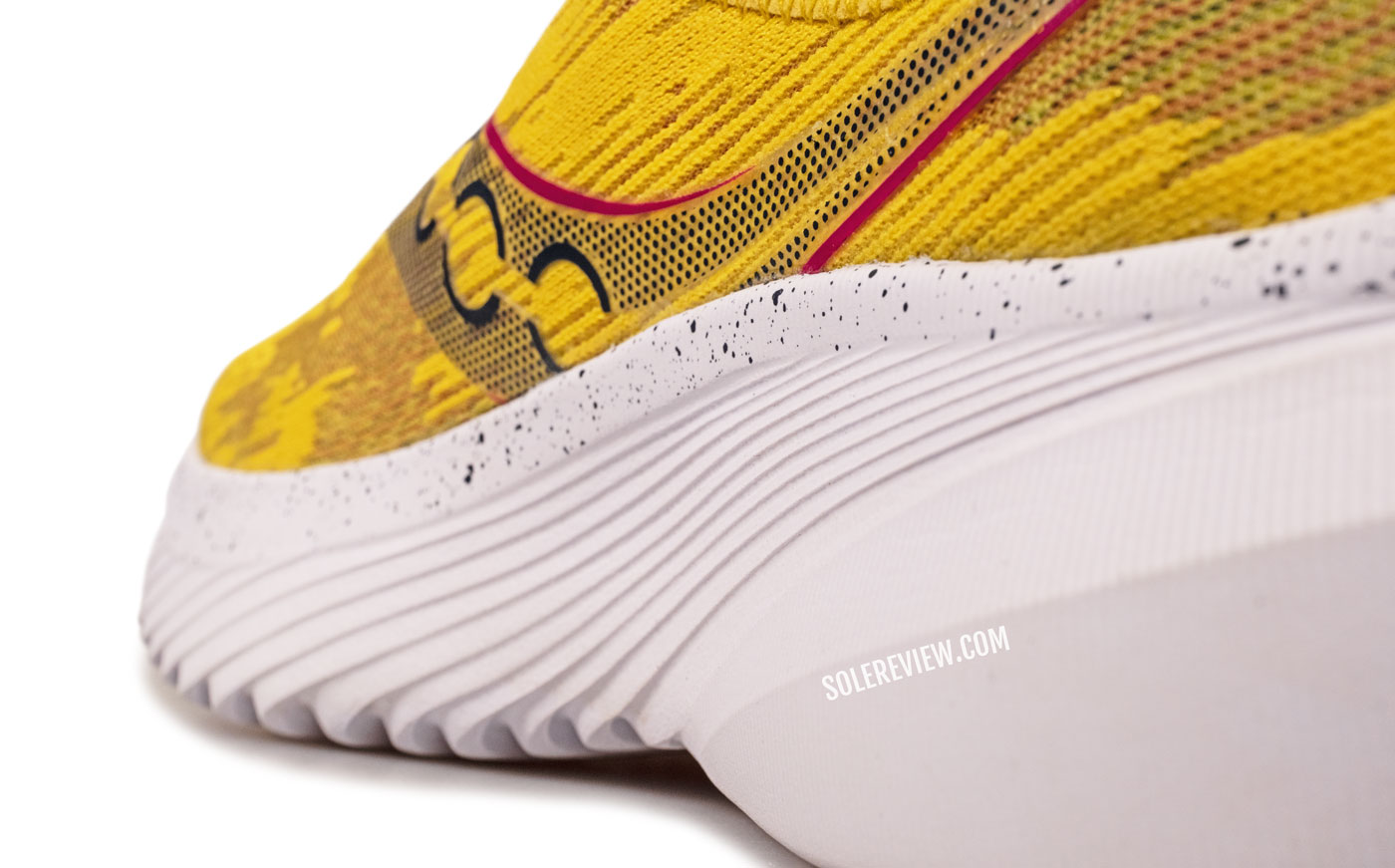
The Kinvara 14 adds 2.5 mm of height to the midsole over the Kinvara 13. The arch area gets raised sidewalls. Not that it makes the midfoot supportive, though. The redesign has the opposite effect.
Other changes include an updated outsole texture (with decreased contact area) and raised midsole sidewalls.
The weight hasn’t changed, with both models hovering at the 7-ounce mark.
Inside, the EVA foam insole and Pwrrun+ topsole of the K-13 have been replaced with a single layer of Pwrrun+ foam. Saucony has made this change across many of its models, including the Ride and Guide.
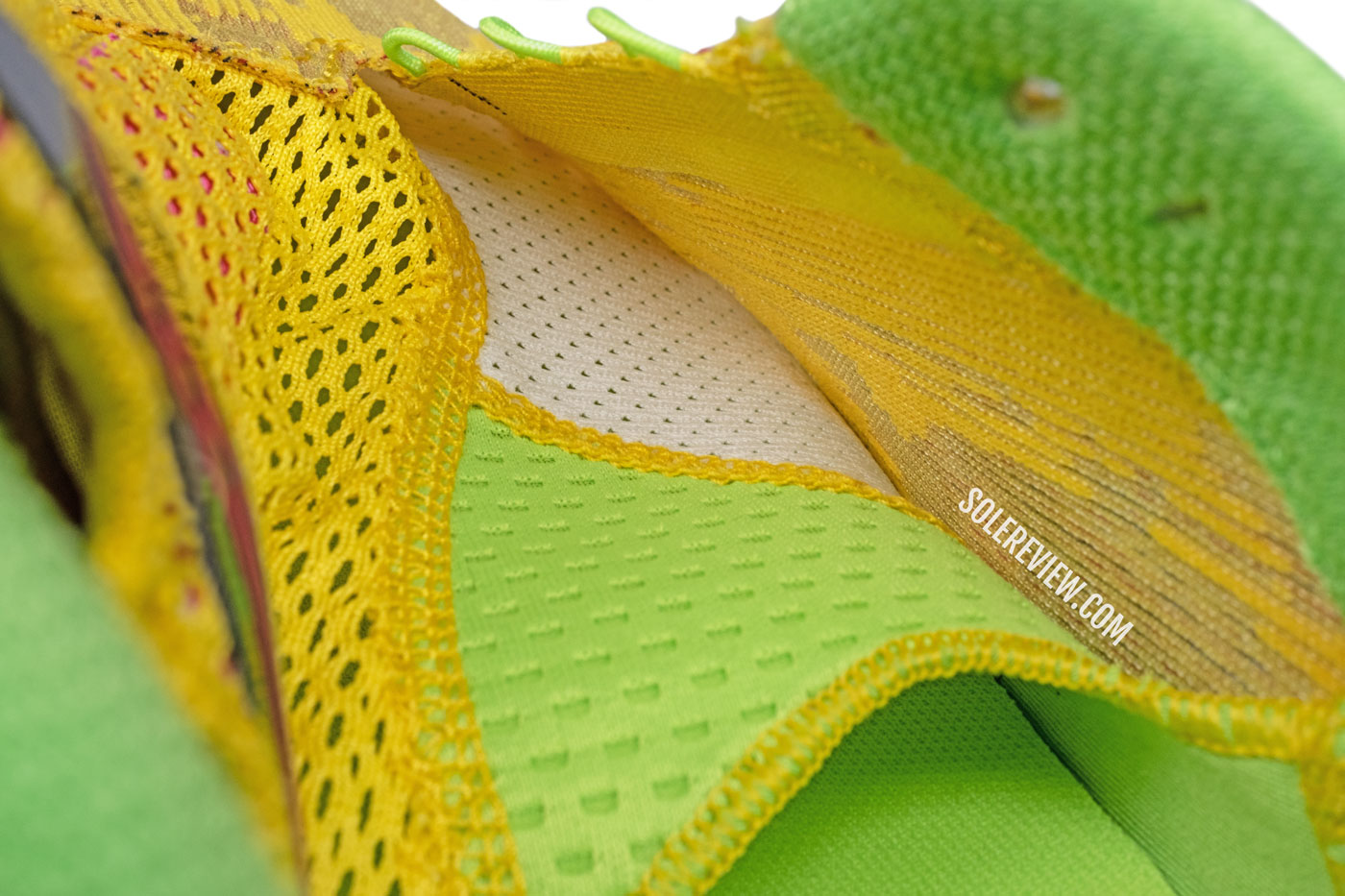
The Kinvara 14 fits much tighter than the 13, and the newly added full sleeve is one of the reasons.
The upper fits a lot narrower, and it’s not as soft, breathable, and distraction-free as the Kinvara 13.
The narrowness can be attributed to the full sleeve (as opposed to a partial gusset on the Kinvara 13) and the change in mesh. The upper also bends inwards over the forefoot due to the excess material and bump caused by the lacing loop.
THE MIDSOLE DESIGN AND RIDE EXPERIENCE
(Note: The issue of midfoot flexibility has been addressed in the preface, so we’ll focus on the other performance areas in the review that follows.)
The thing we loved most about the Kinvara 13 was its unassuming, get-out-of-the-way ride character. The thin and flexible midsole let the foot do its work by encouraging proprioception and ground feel. The soft and lightweight upper paired perfectly with the minimal midsole.
Many core character traits runners that expect from the Kinvara are not available on the 14. The loss of connection with the ground is immediately noticed, even during the first run.
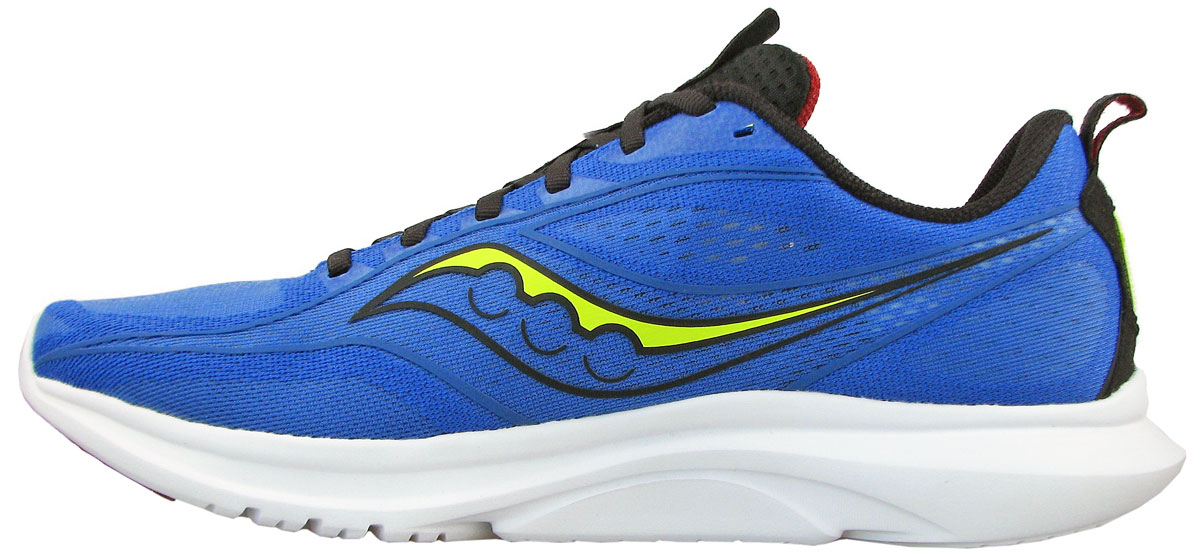
The Kinvara 13’s midfoot was reinforced with a foam pillar for smoother transitions and midfoot-strike compatibility. Note the absence of a high toe spring or rocker profile.
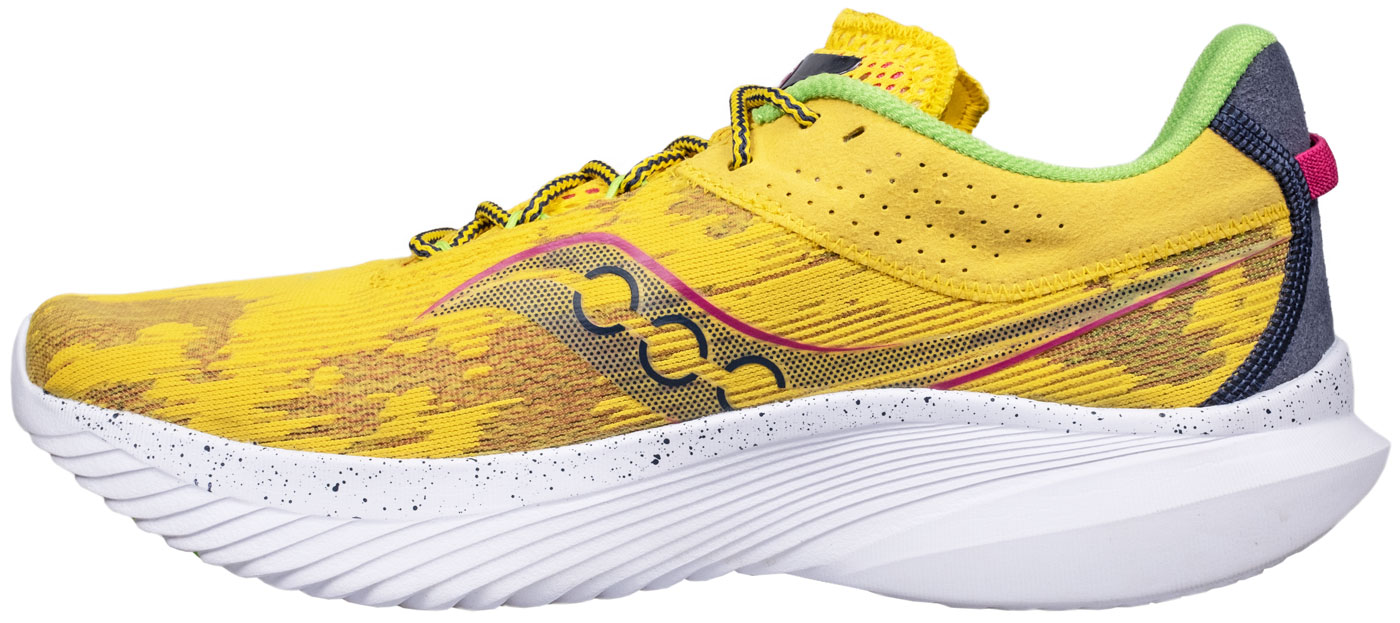
The difference on the Kinvara 14’s midsole is noticed instantly. The forefoot curves upwards in a rocker profile, and the ‘scooped’ midfoot no longer touches the surface it’s on.
It’s not just the 2.5 mm thicker midsole that dilutes the feedback. The rocker shape prevents the foot from doing two things: spreading the outsole flat over the road to increase the contact area, while limiting push-offs with the large toe.
The Kinvara 14 is also a harder shoe to do intervals in.
Switching gears during interval training requires greater effort. The rocker midsole decreases the overall contact area for the foot to launch from. The softer forefoot also gets in the way, and so does the average outsole grip.
While the Kinvara has never had a proper outsole in a technical sense, the traction was never an issue. On all the prior editions of the Kinvara, the midsole would spread wide when loaded and make full contact with the road. Thus, the quality of grip was good enough for most use cases.
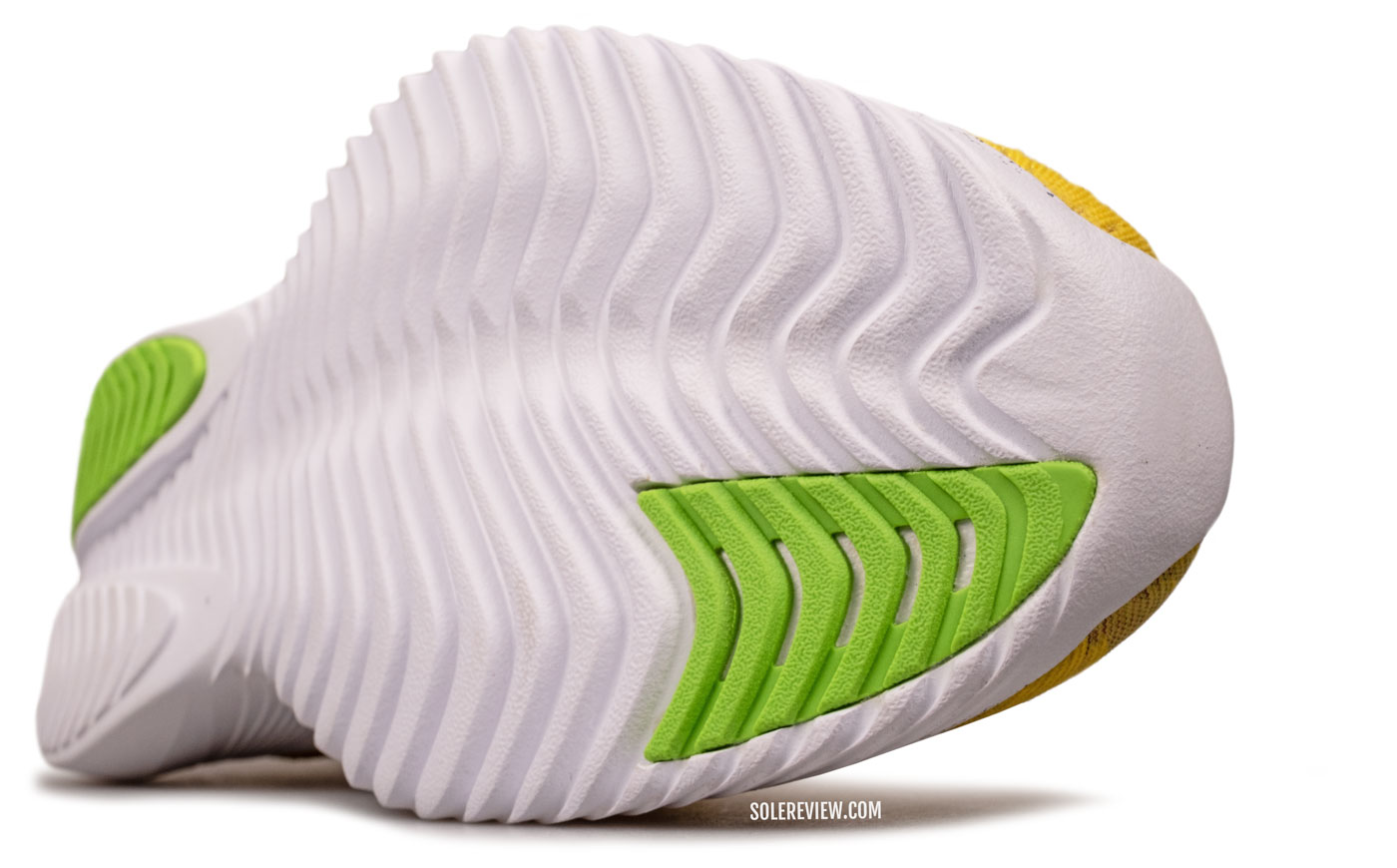
There’s a groove running down the forefoot that decreases the contact area – thereby affecting the outsole grip. The Kinvara 13’s grooves were on the sides and not in the dead center of the forefoot.
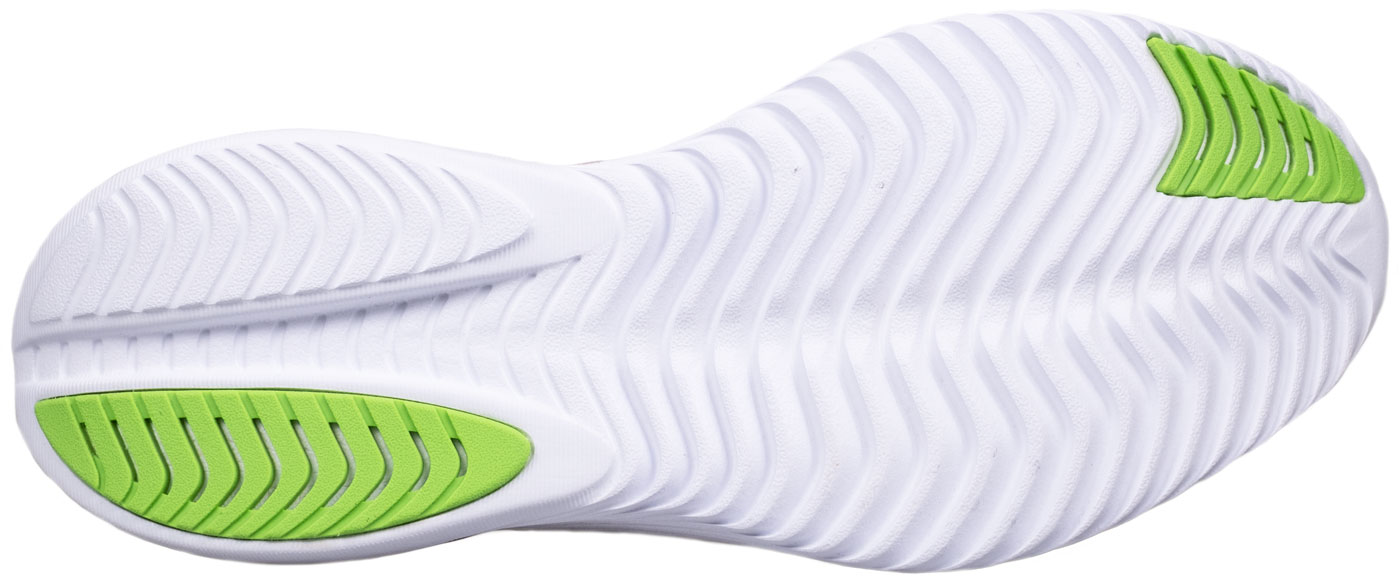
The recessed midfoot, rocker shape, and dent from the forefoot groove hurt the quality of the sole grip.
In contrast, the rocker midsole prevents the Kinvara 14 from making full contact during take-offs.
Unlike the full ground-contact design of the Kinvara 13, the midfoot of the Kinvara 14 is recessed and doesn’t make contact. The outsole grip is one of the things that makes or breaks a running shoe’s interval-training capabilities.
On a related note, the Kinvara 14 should only be worn in temperatures above freezing. The outsole behaves like an ice skate even on the smallest patch of frosted sidewalks. When we combine the loss of outsole grip and ground feedback with a weaker power delivery to the road, the Kinvara’s ability to tackle interval runs is greatly diminished.
The loss of direct ground feedback and proprioception is very noticeable, as the Kinvara delegates a lot of transition-related duties to the thicker (and rockered) midsole.
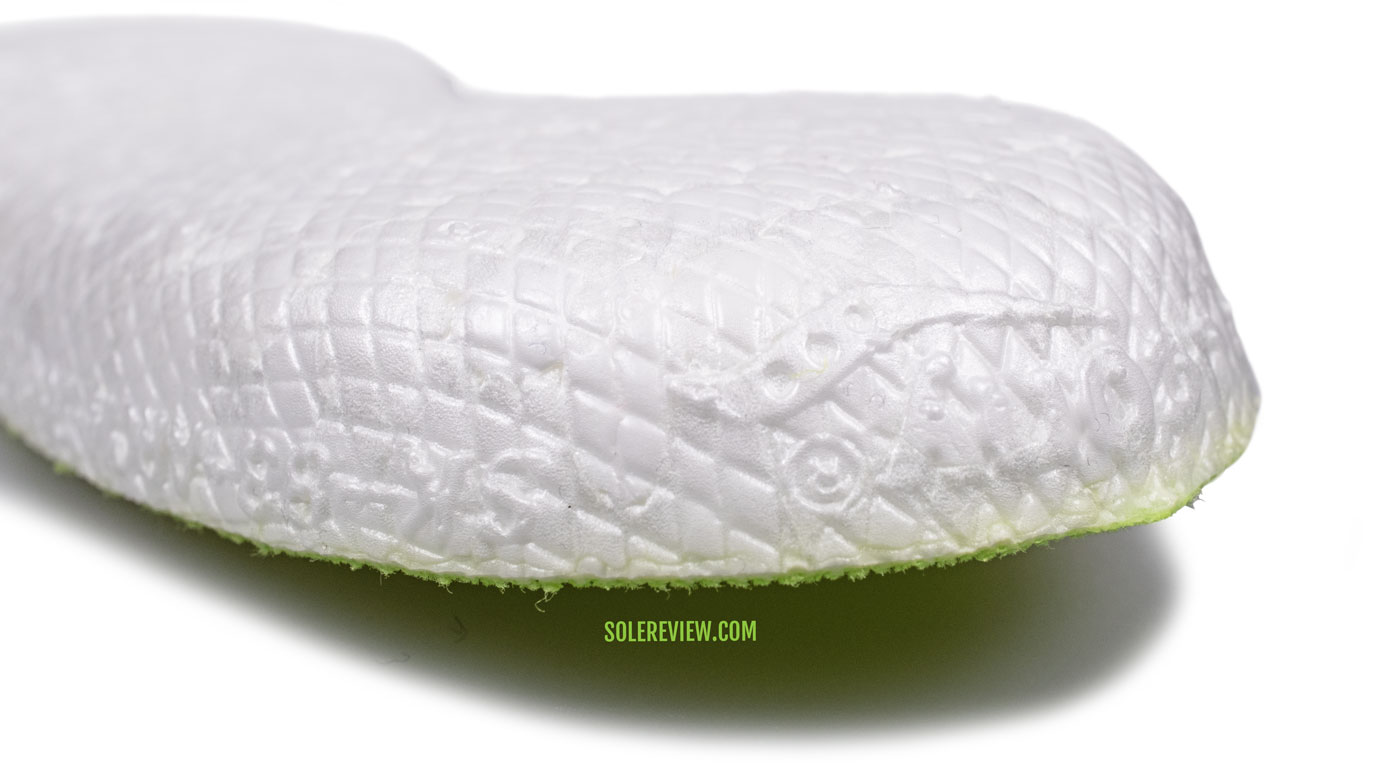
The Pwrrun+ foam insole is new for the Kinvara 14, and creates that first layer of cushioning under the foot.
The midsole cushioning feels very new and different. The cushioning is much deeper; the forefoot particularly so. Not only is the midsole taller by a few mm, but the foam density is also lower. Also, the footbed is now made entirely of Pwrrun+ and creates a cushioned layer of superficial softness.
As for the midsole specs, the Kinvara 14 has a 4 mm drop with 31 mm (heel) and 27 mm (forefoot) stack heights.
RECOMMENDED ROTATION
If you’re running in the Kinvara 14 with no problems, a good rotational strategy would involve the Saucony Triumph 21 for daily runs and easy long miles and the Endorphin Speed 3 for marathons.
Else, we found the Asics Superblast to be more versatile than the Triumph 21 while being equally durable. If you don’t want the Saucony Endorphin Speed, the New Balance SC Elite V3 or Nike Vaporfly 3 are excellent marathon racers with a plate.
IS THE SAUCONY KINVARA 14 DURABLE?
In all history, the Kinvara has never had a full rubber outsole; just selectively-placed lugs under the heel and forefoot.
The EVA foam midsole/outsole is surprisingly durable, so the Kinvara has a useful life of 400 miles or more.
The upper doesn’t have weak (durability-related) spots, and we haven’t received feedback to the contrary.
THE UPPER DESIGN AND FIT
The Kinvara 14 is the tightest Kinvara ever. The toe-box is also the pointiest it’s ever been. The toe-box ceiling also feels lower, despite having an internal toe-bumper. Runners who loved the spacious forefoot and toe box of the Kinvara 13 will be surprised by the changed fit.
There’s noticeable tightness over the small toe, and even the base of the large toe feels boxed in.
Does the upper fit true to size? Yes, but that’s the only thing that the Kinvara 14 has in common with the Kinvara 13.
So what causes the fit to change so much? As far as we can tell, that’s mostly due to the addition of a full sleeve. Unlike the Kinvara 13 which had just one mesh layer and a thin gusset (which was confined to the midfoot), the Kinvara 14’s exterior is made of two meshes stacked together.
As expected, the sleeved design makes the upper warmer. Two layers of textiles do not breathe as well as a single layer of perforated mesh does.
A tight upper isn’t a fault per se. However, a poorly thought out construction is. When bending the foot, the upper gathers and presses down on the base of the large toe. This distraction is a stark contrast from the well-proportioned upper of the Kinvara 13.
The first row of the lace loop creates that hot spot. Unlike the last model, the Kinvara 14 introduces fabric cords for the first three lacing rows. Adding the round cords creates another layer of thickness that did not exist on the Kinvara 13.
The speed loops are a gratuitous add-on. With the upper already so tight and secure, they serve no purpose.
We don’t understand what the deal is with the tongue either. Saucony swaps the previously soft and padded tongue with a new design that rides up the instep. Not that it rubs against the foot or anything, but it’s rather pointless, don’t you think?
The updated heel puts in a shorter internal cup. The heel counter – the stiff part that gives the back its shape – is shorter than the Kinvara 13.
Though the heel feels a bit less supportive, we did not experience any heel slippage. The shorter heel stiffer also makes the Achilles’ lip softer. Some runners might feel differently, and find the heel fit to be less than ideal.
The updated Kinvara is also missing the heel pull from the previous model, and reflectivity was seldom available on the Kinvara, so there’s nothing to report this time either.
ORTHOTIC COMPATIBILITY
Given its design flaws, the Kinvara 14 will perform better with an orthotic. Ideally, the aftermarket footbed should have a supportive midfoot and arch to compensate for the flawed midsole.
The good news is that the stock Pwrrun+ footbed is thick enough to be replaced with another insole of matching dimensions. Pictured here is the Kinvara 14 with a Superfeet Green insole.
PROS AND CONS
This review dissuades you from buying the Kinvara, so making a list of its positives is a moot point. Sure, it’s lightweight, cushioned, and all that, but what’s the point if the midsole bends in the wrong place?
The other not-so-good things would be tighter and slightly uncomfortable upper. The outsole grip is average too.
COMPARISON: THE SAUCONY KINVARA 14 VERSUS SAUCONY KINVARA PRO
While the Kinvara Pro borrows several recognizable design elements from the Kinvara, comparing both doesn’t make a lot of sense, considering how different they are.
The Kinvara Pro is 11 mm taller (42 mm) under the heel and 7 mm thicker (34 mm) in the front. That also gives the Pro an 8 mm drop versus the 4 mm heel drop of the Kinvara 14.
Besides the Pwrrun+ footbed, the Kinvara Pro has a Pwrrun PB layer on top, a 3/4th Carbon plate under it, and the base layer made of a firmer EVA foam.
It’s worth pointing out that while the midsole composition appears to be a 40:60 split (40% Pwrrun PB, 60% EVA) from the outside, the usable percentage is much lower.
Much of the Pwrrun PB you see from the outside forms the cupped edges or sidewall; the usable section is significantly thinner (around half of the perceived thickness). This means that the EVA foam part plays a larger role in the cushioning delivery.
On the bright side, the firmer EVA casing makes the Kinvara Pro very supportive for its stack height. However, outsole rubber is completely lacking (not even the obligatory heel plug).
The Kinvara Pro’s upper is also nice – the overall fit and feel is much closer to the Kinvara 13 than the current generation Kinvara. The upper is soft, breathable, and doesn’t use a full sleeve as the K-14 does – just a partial gusset.
There’s nothing wrong with the Kinvara Pro, but it fails to make a strong case for itself. We’re not sure where exactly Saucony was going with this shoe. Is it supposed to compete with the New Balance SC Trainer and Nike Zoom Fly 5? If so, we’d choose the latter – because the Kinvara Pro’s reason to exist isn’t very clear. It doesn’t have the engaging ride comfort of the SC Trainer and ZF5. It’s not a speed trainer. It doesn’t have even an outsole.
SHOES COMPARABLE TO THE SAUCONY KINVARA 14
If you are to avoid the Kinvara, the closest Saucony match would be the Convergence. It’s a $70 trainer that uses the Kinvara 13 midsole but is built to a lower spec level. This 4 mm drop trainer does not have any Pwrrun+ (e-TPU) parts, but it makes up with the lower price and 6.9-ounce weight.
The New Balance Fuelcell Rebel 3 interprets the low-drop, low-interference trainer concept best through modern materials and design. A Fuelcell foam midsole makes the ride engaging while allowing the runner to do the footwork. The Rebel has no ‘transition assist’ features like a midsole rocker or a plate.
The adidas adizero SL lives in the shadow of the Boston 12, Takumi 9, and adios 8. But it is an underrated running shoe that blends mid-distance (10K) comfort with speed manners.
Most of its midsole is made of EVA foam with a Lightstrike Pro (adidas’s high-performance foam) insert under the forefoot. The full outsole and its defined lugs add durability as well as the traction that makes fast touch-and-go runs possible. Within this list, the adizero SL is your best bet as an interval trainer.
The Hoka Mach 5 is also a competent alternative that’s cushioned and fast. The dual-layer midsole isn’t stiff, so it shares the workload with the foot rather than completely taking over.
Finally, Nike loyalists may want to try the Rival Fly 3. The forefoot Zoom Air bag dulls the ground feedback, otherwise it’s a no-frills trainer that works very well for tempo training.
Do you own this shoe? Improve this review by sharing your insights.

